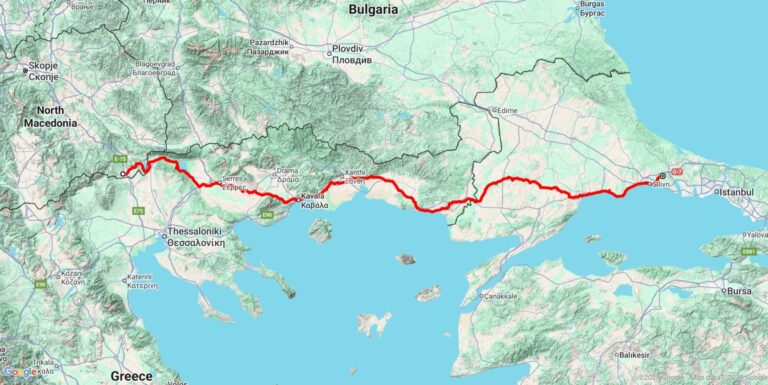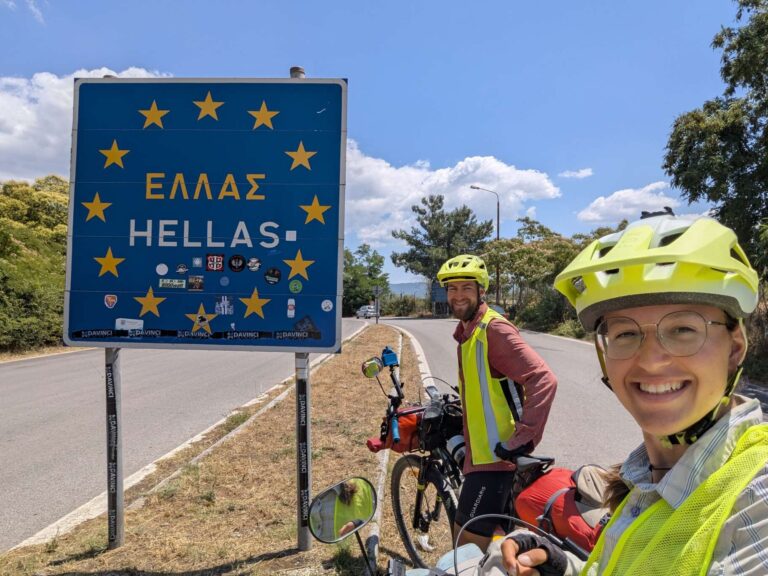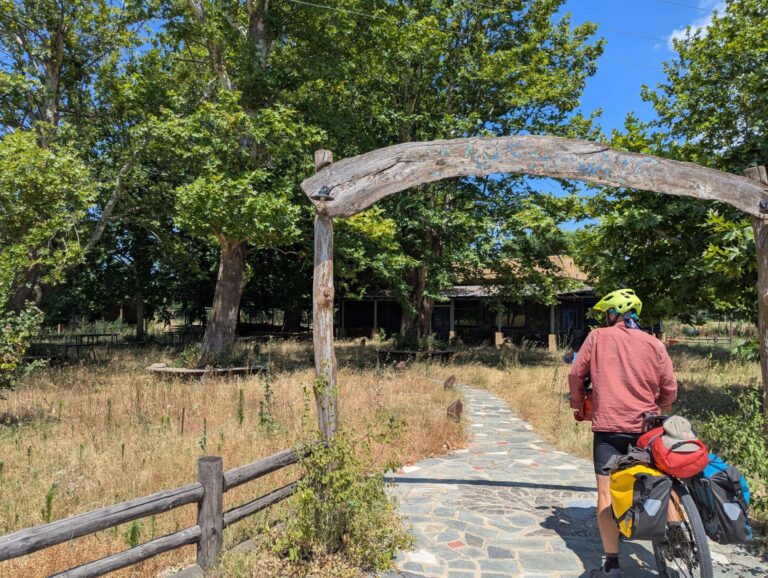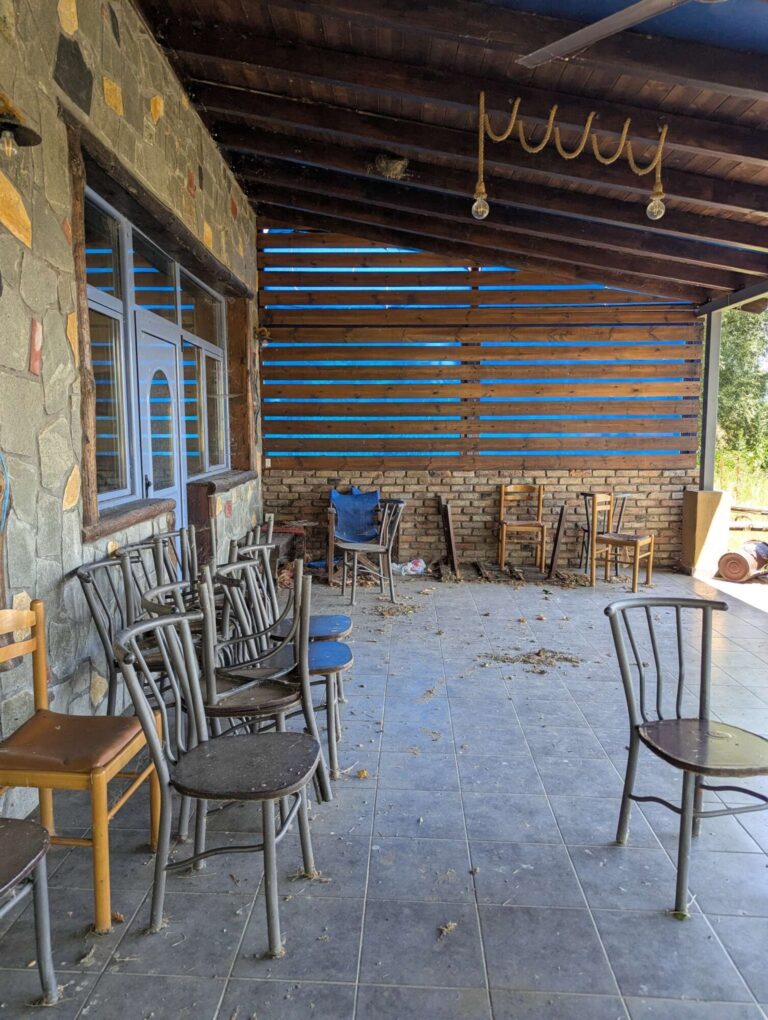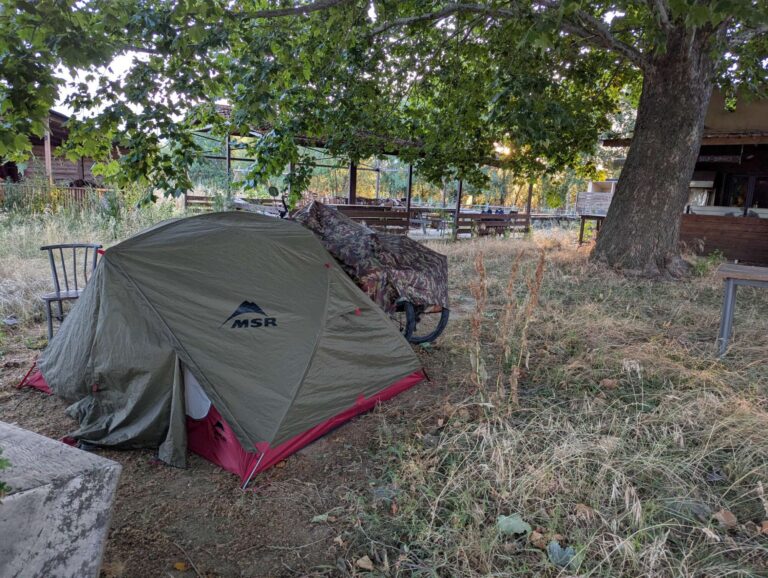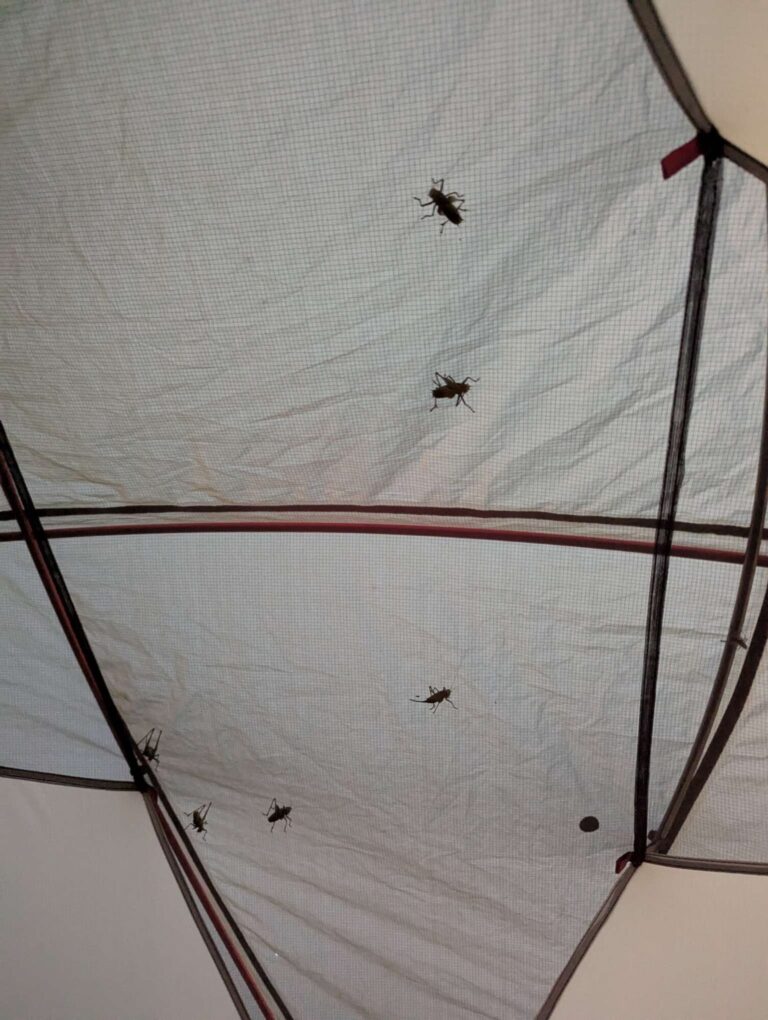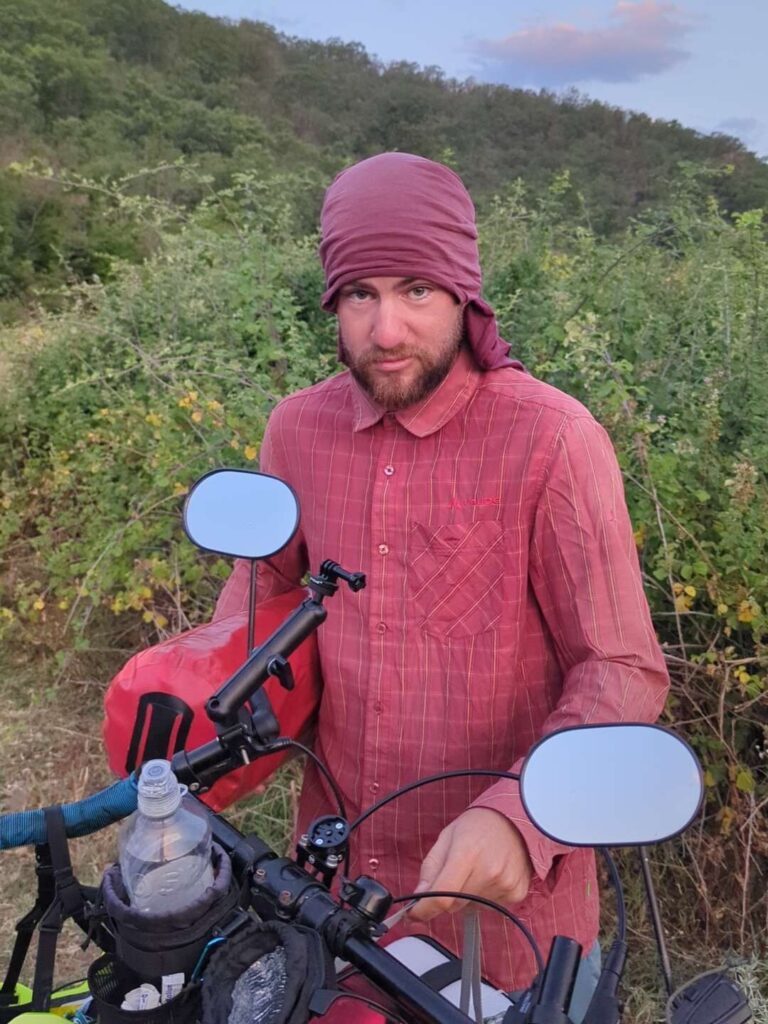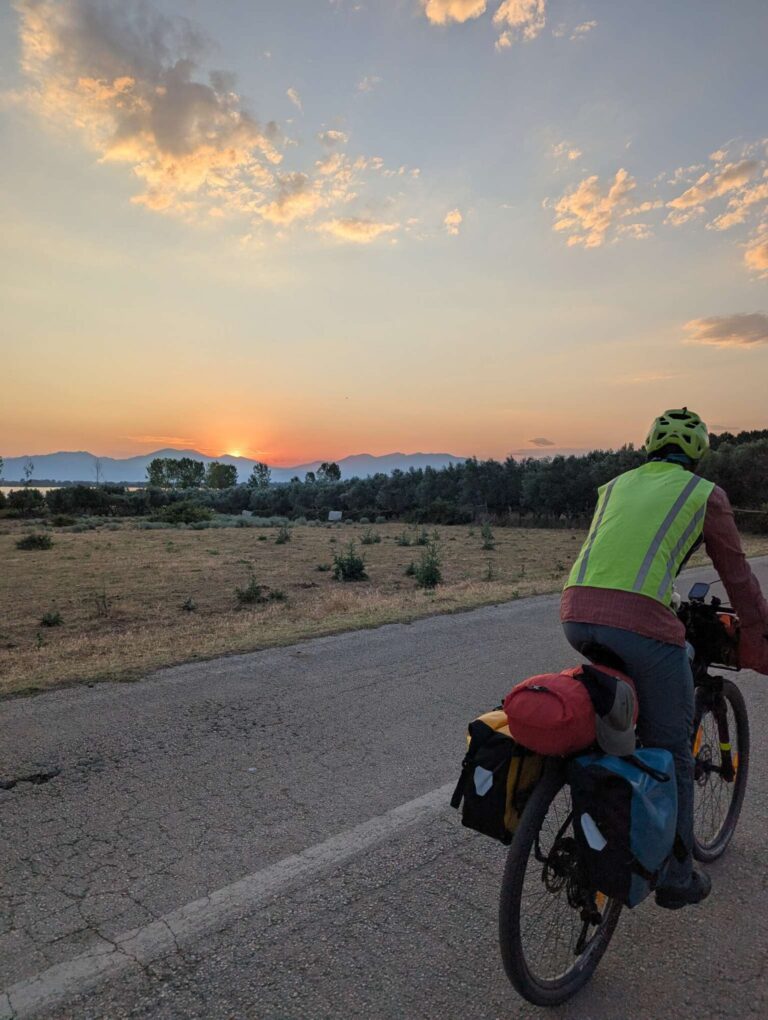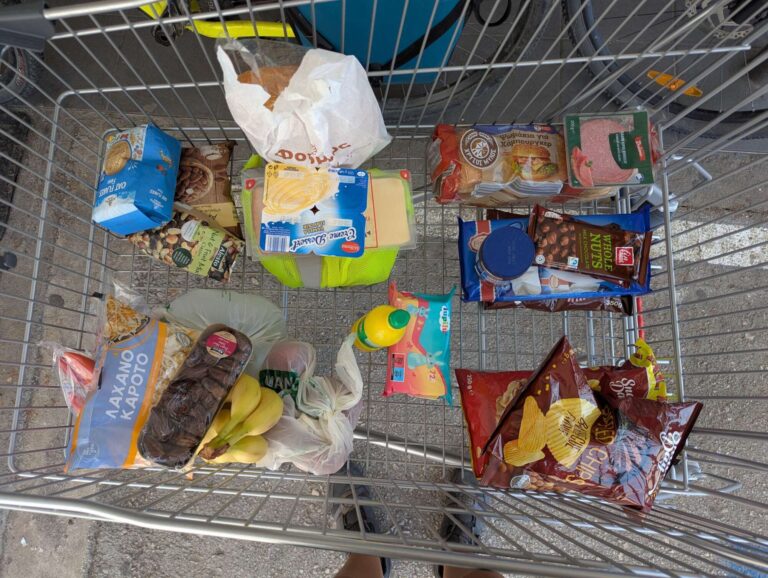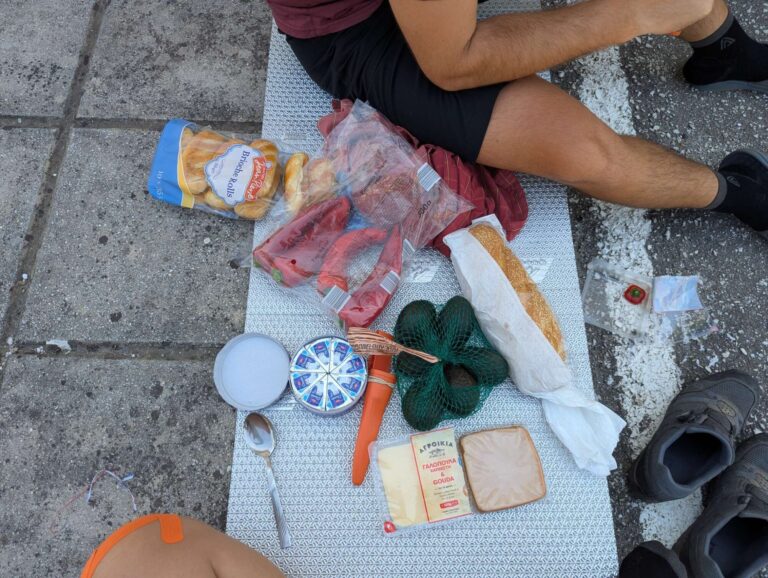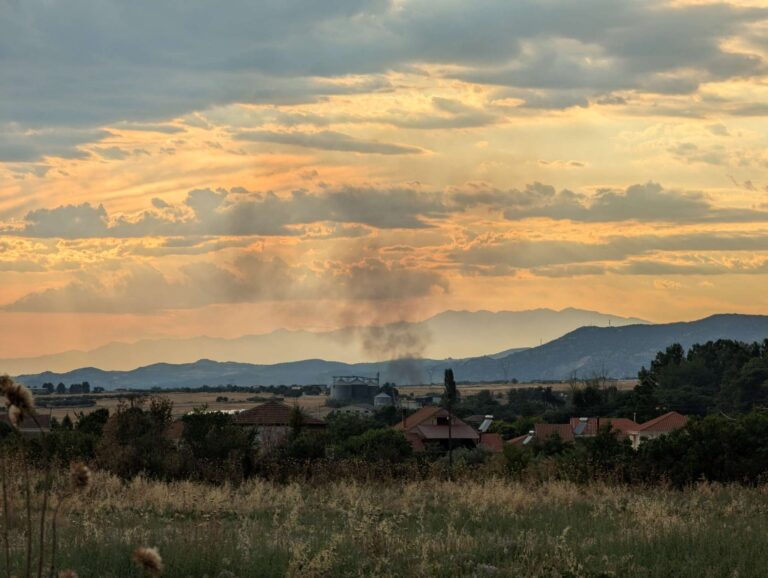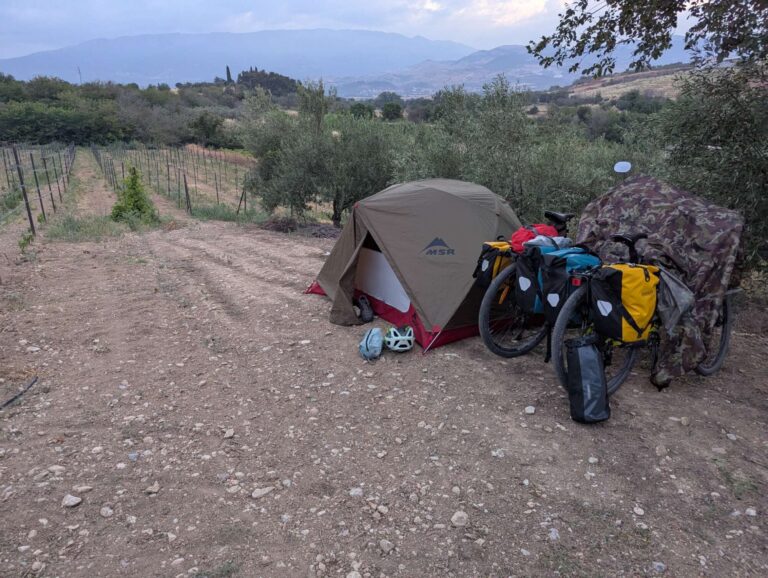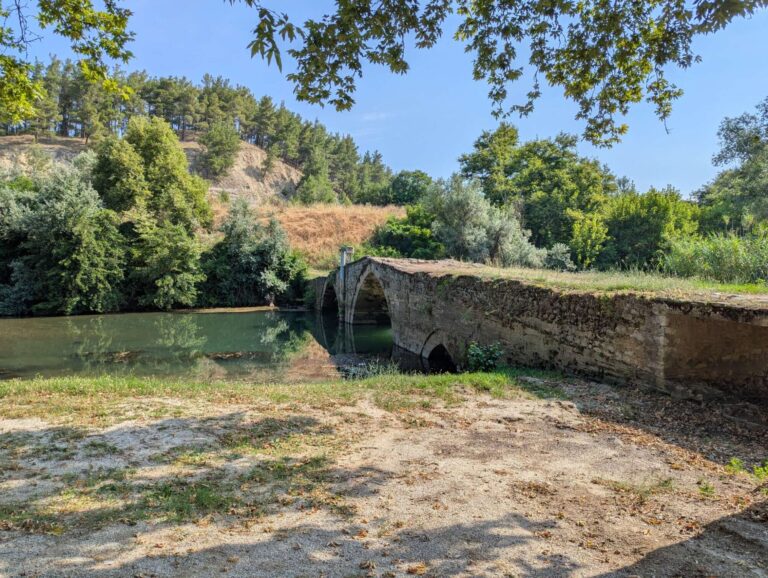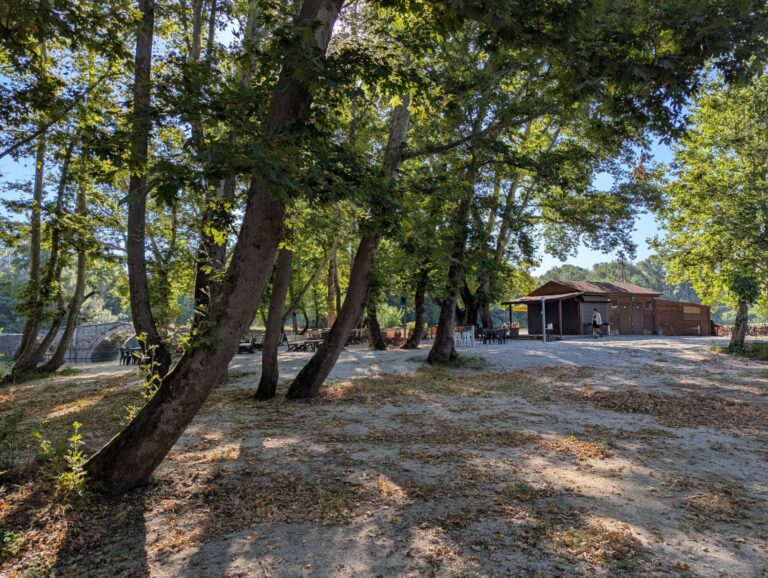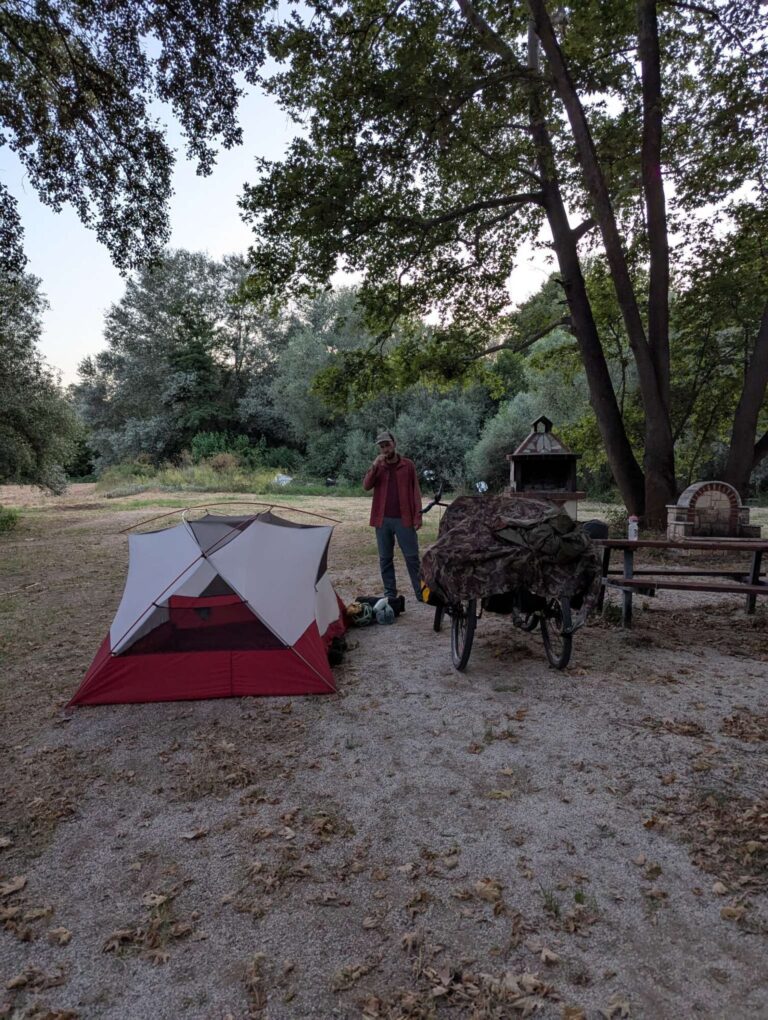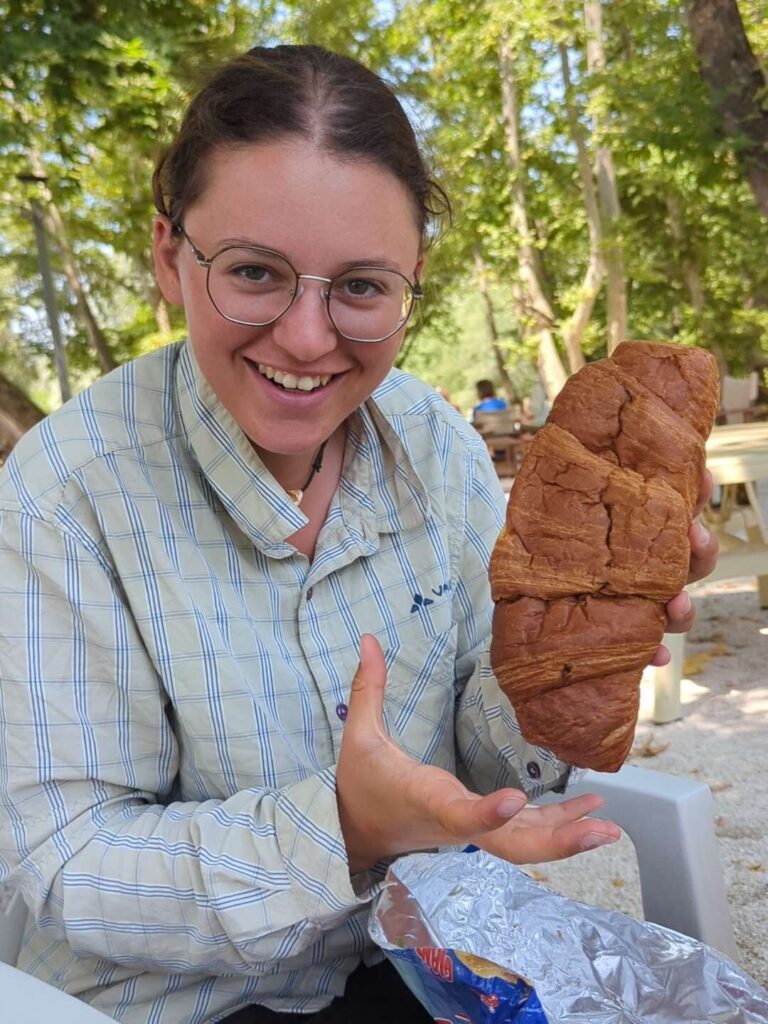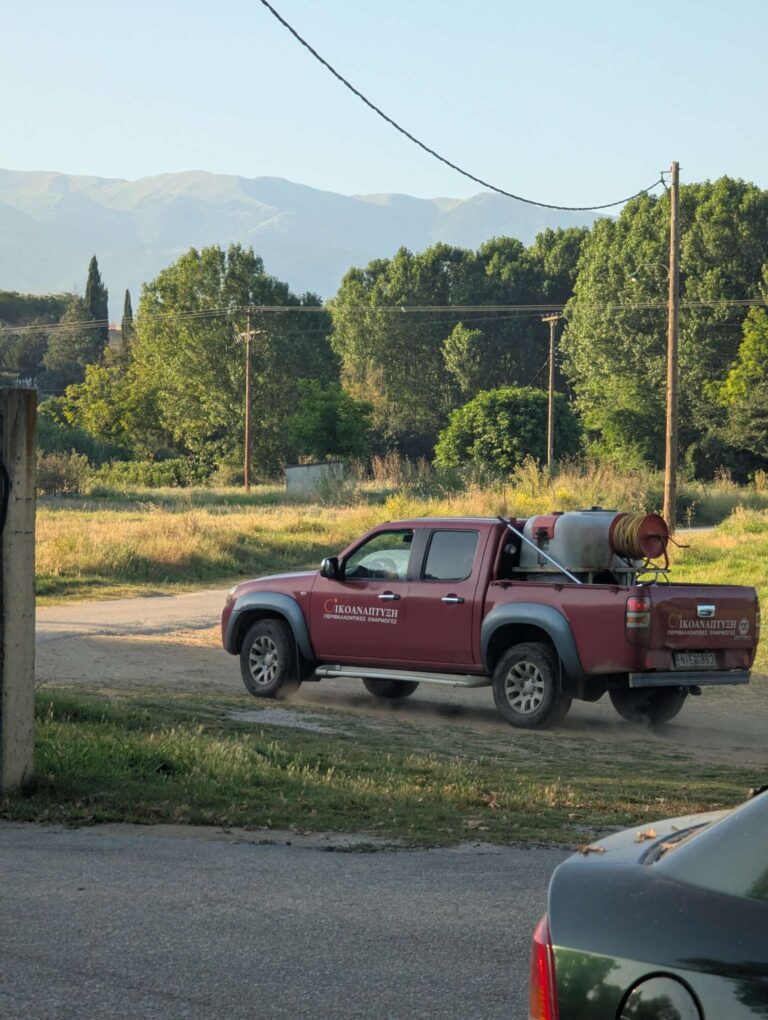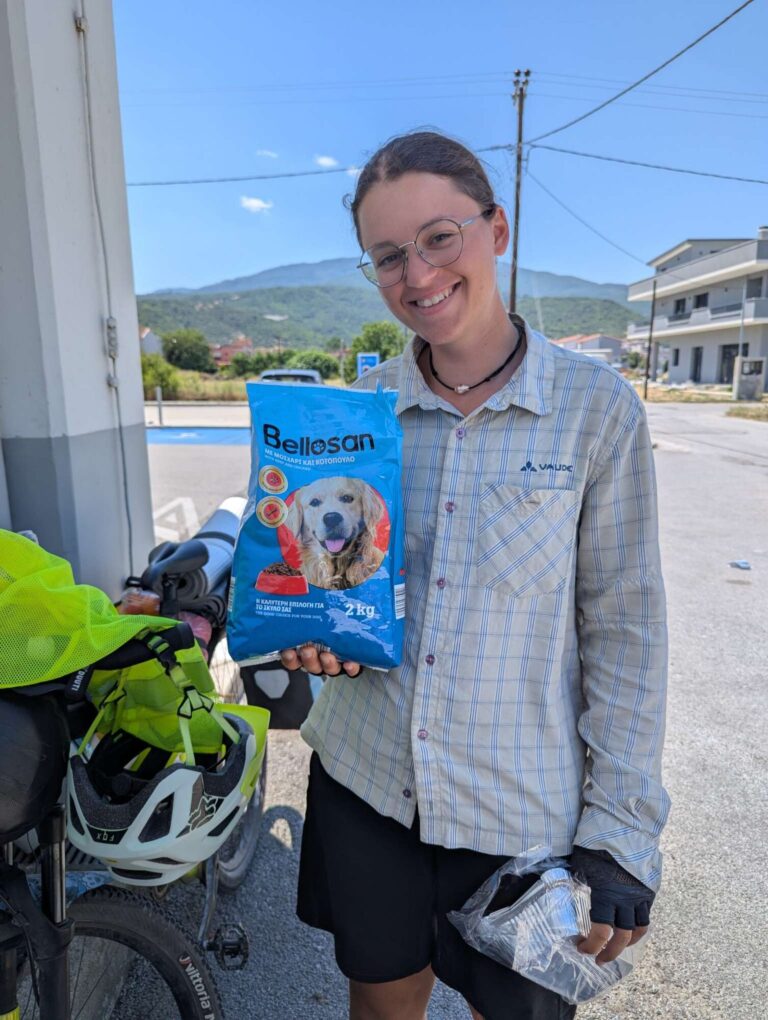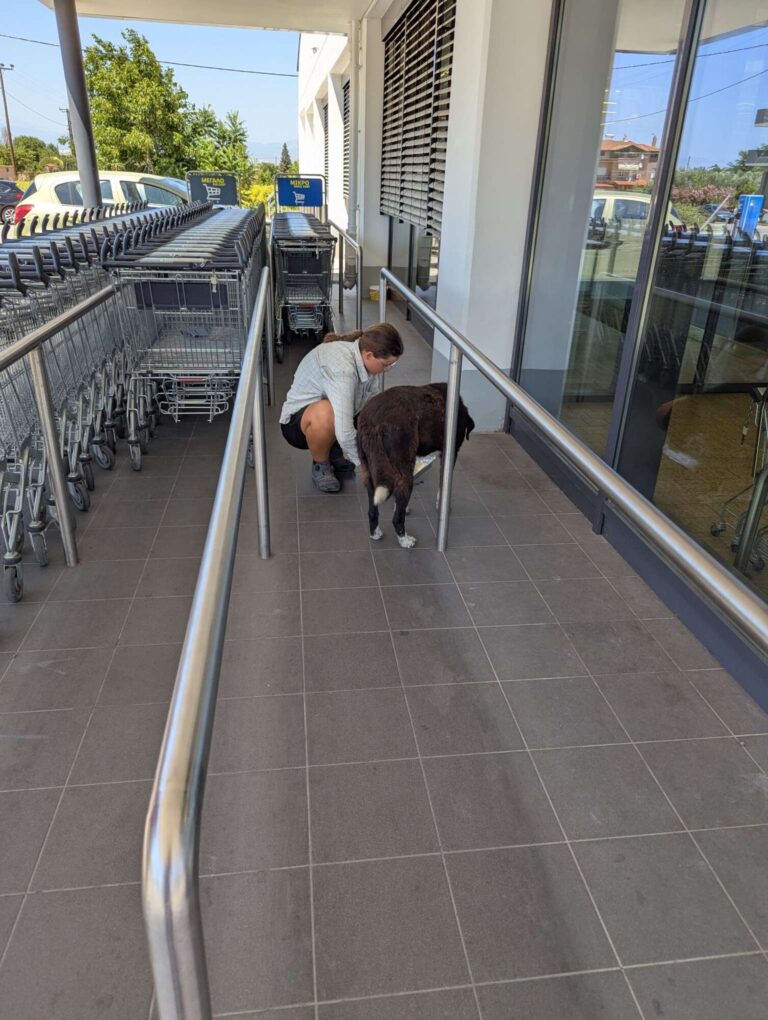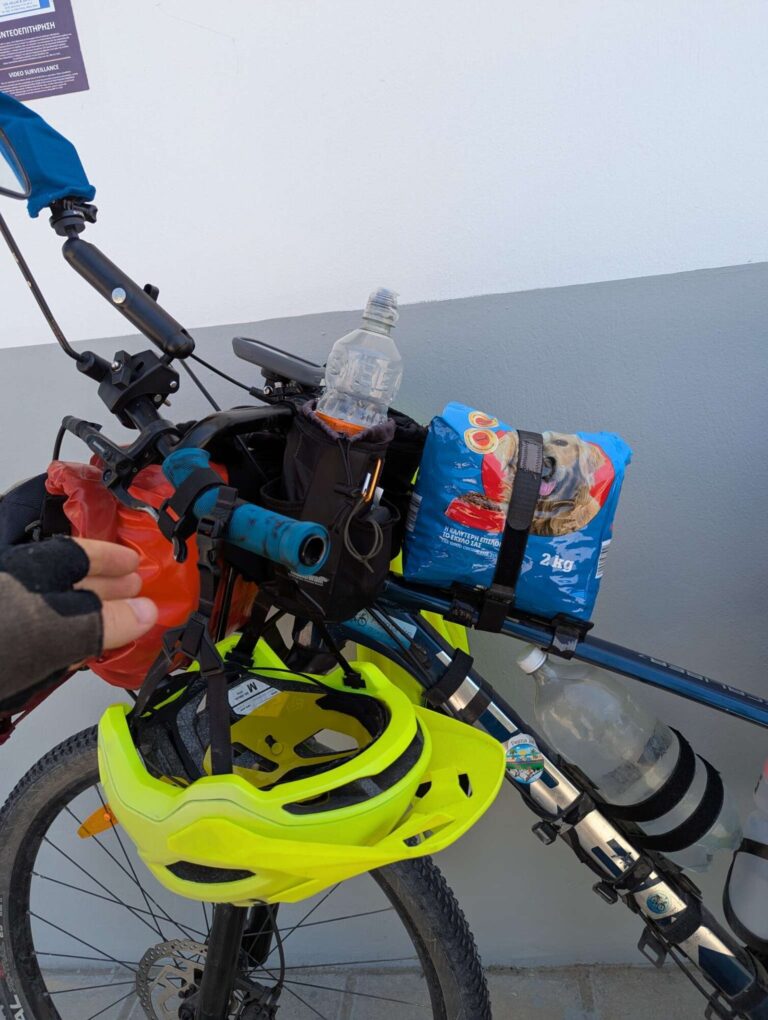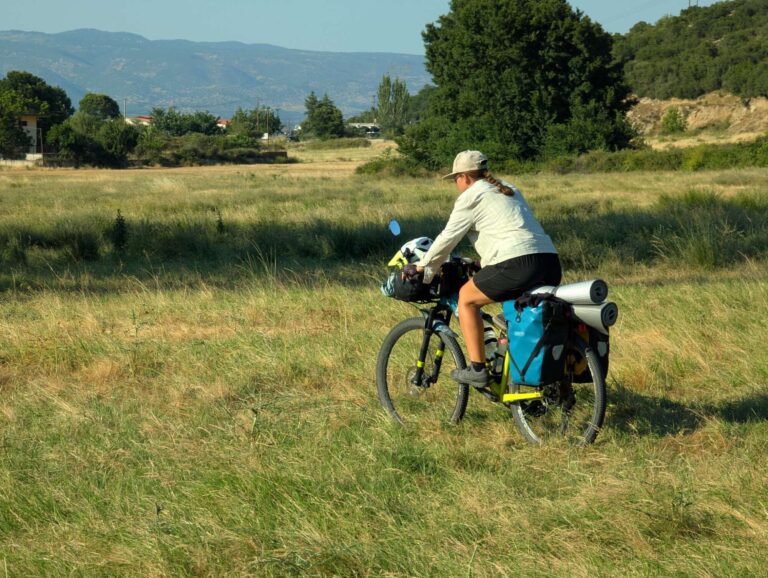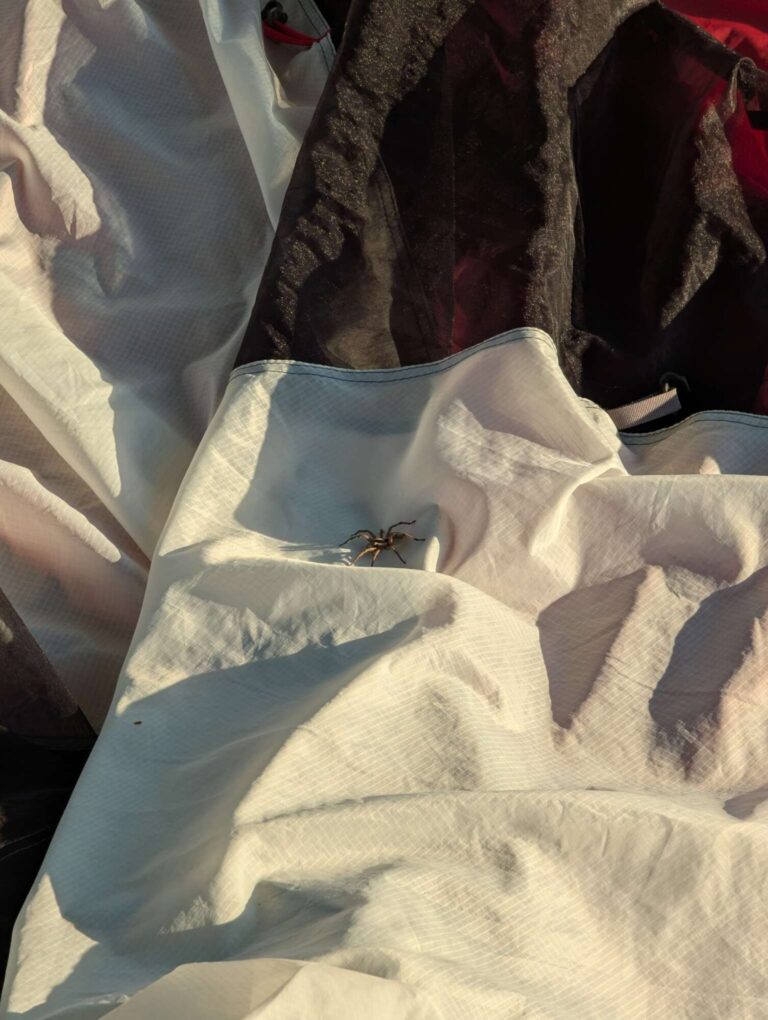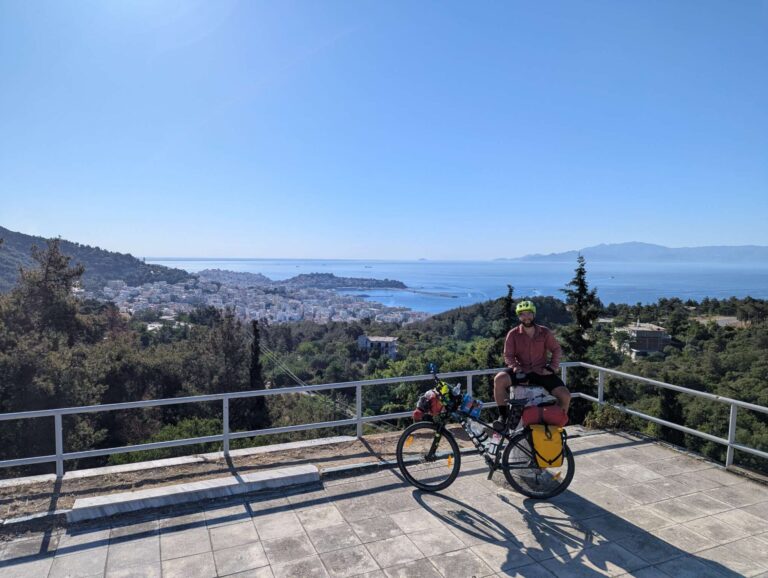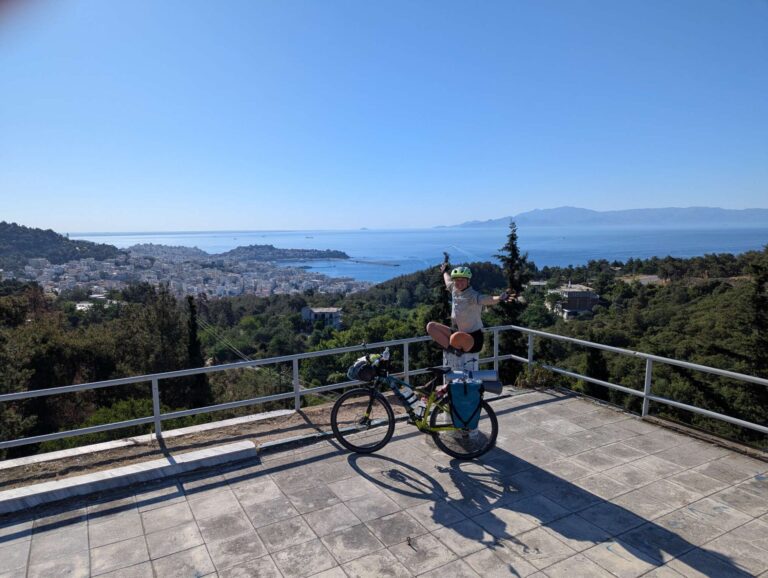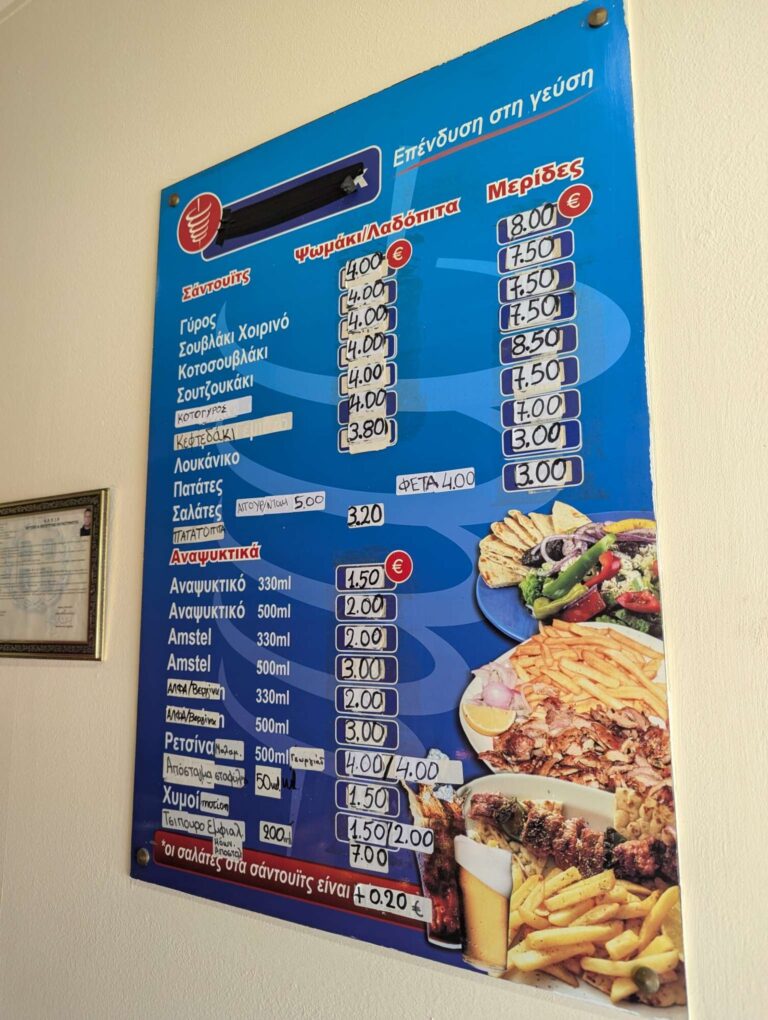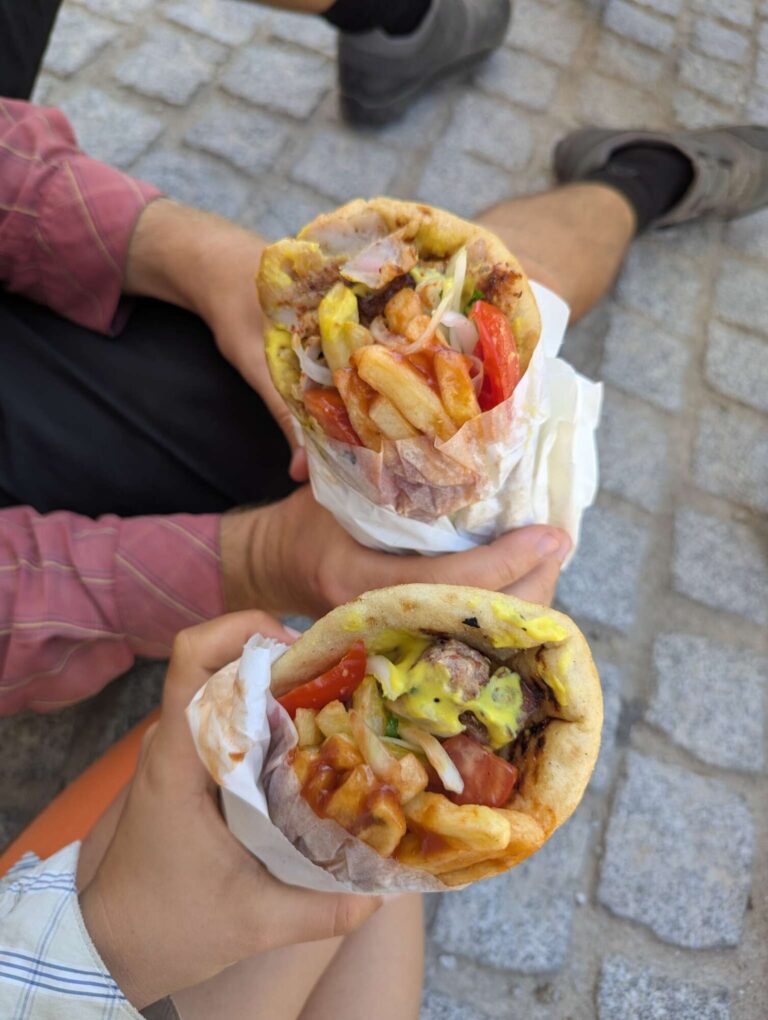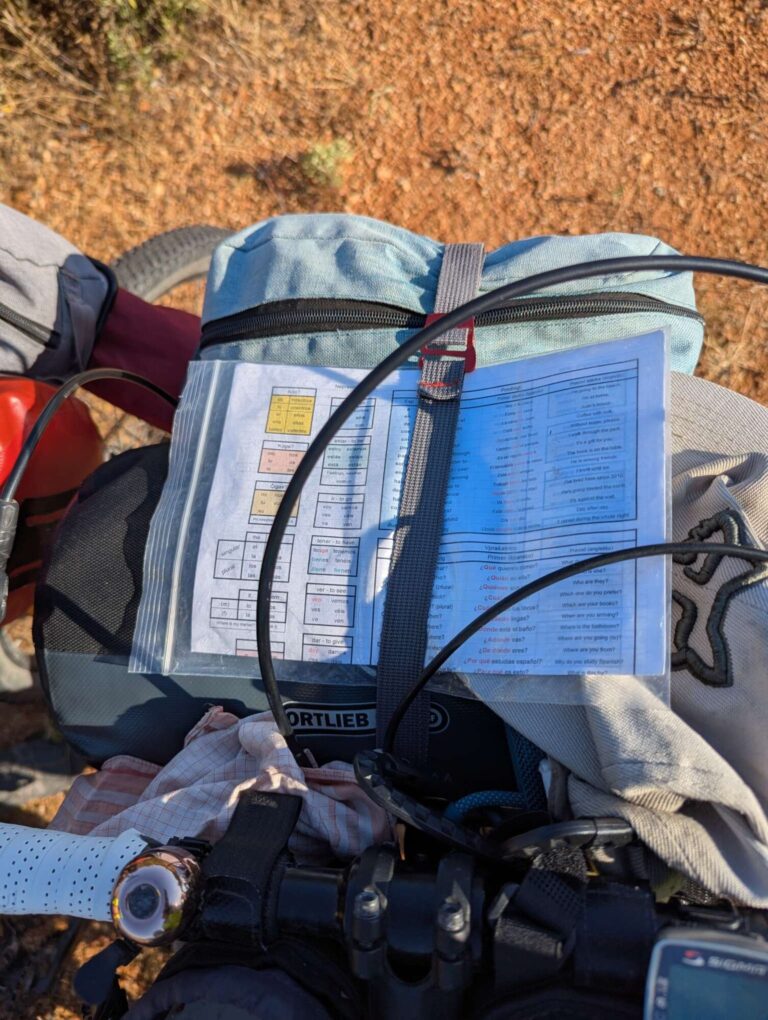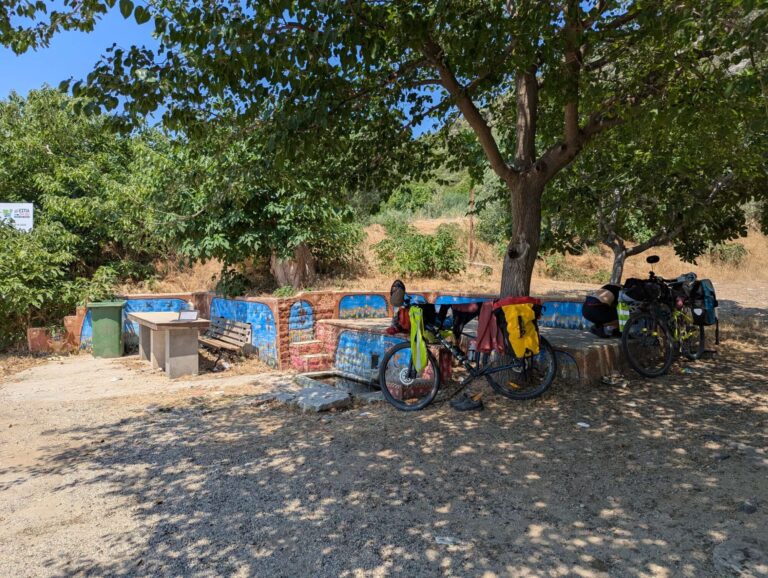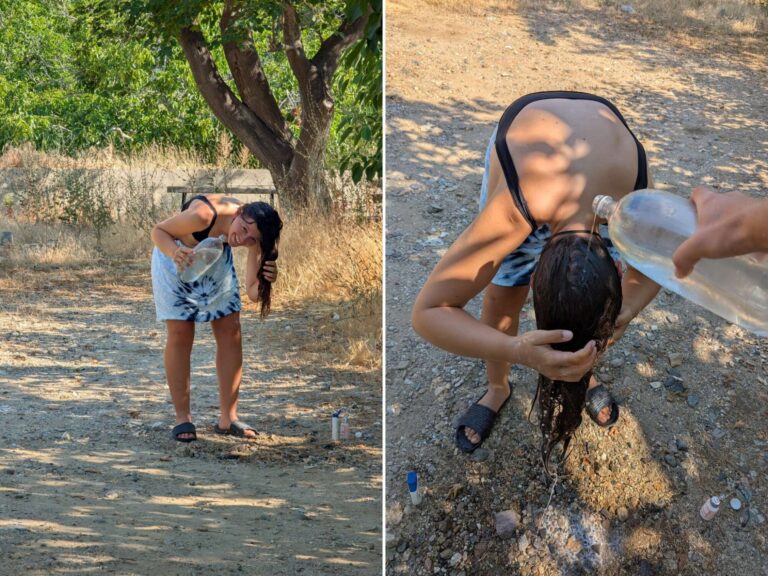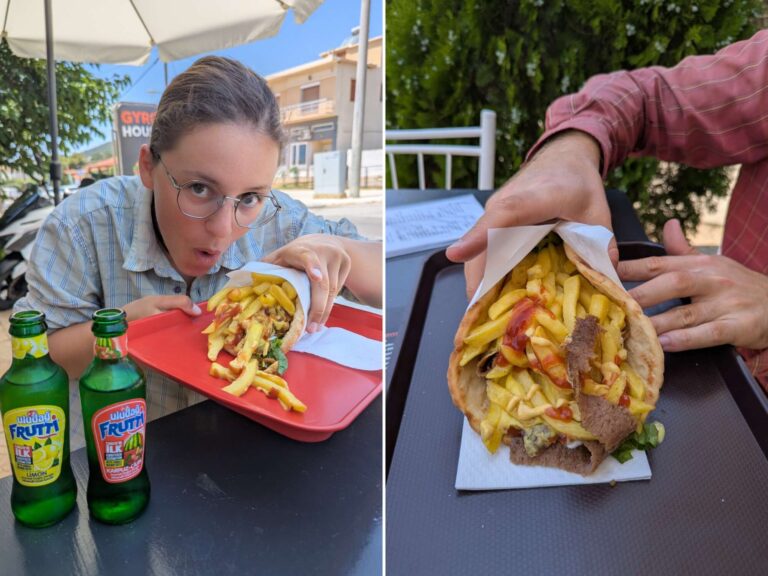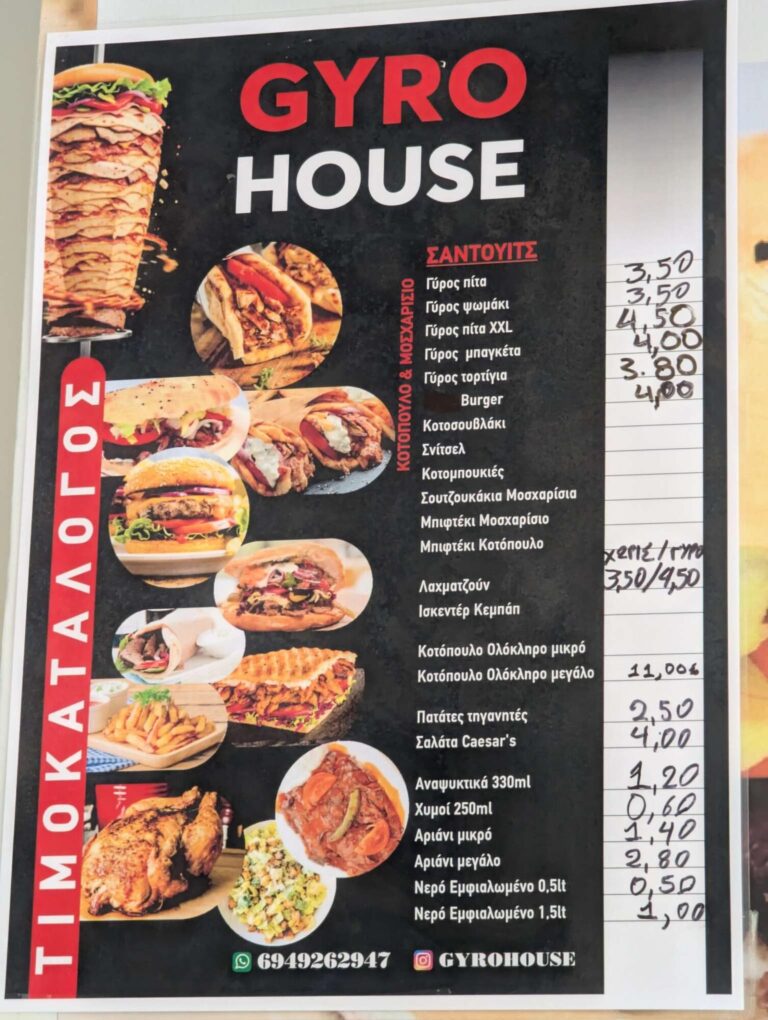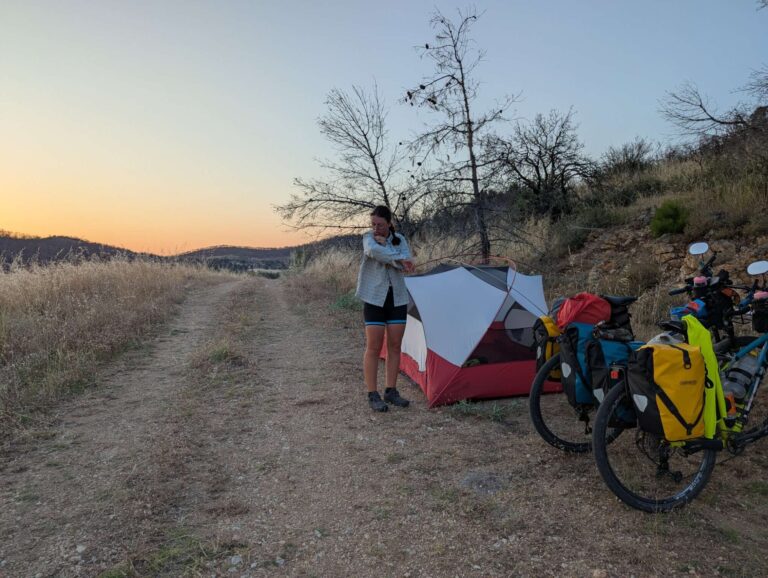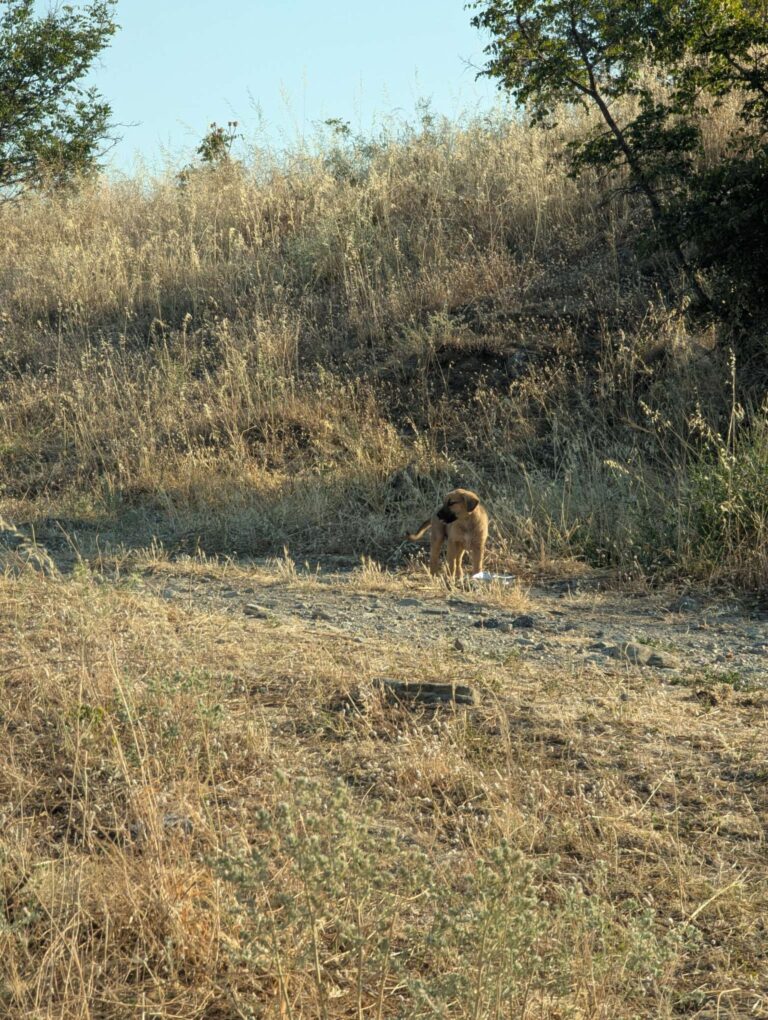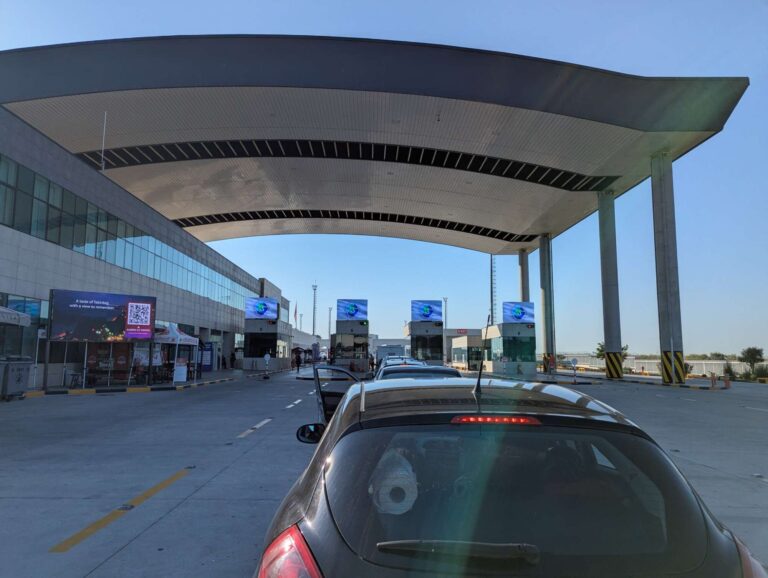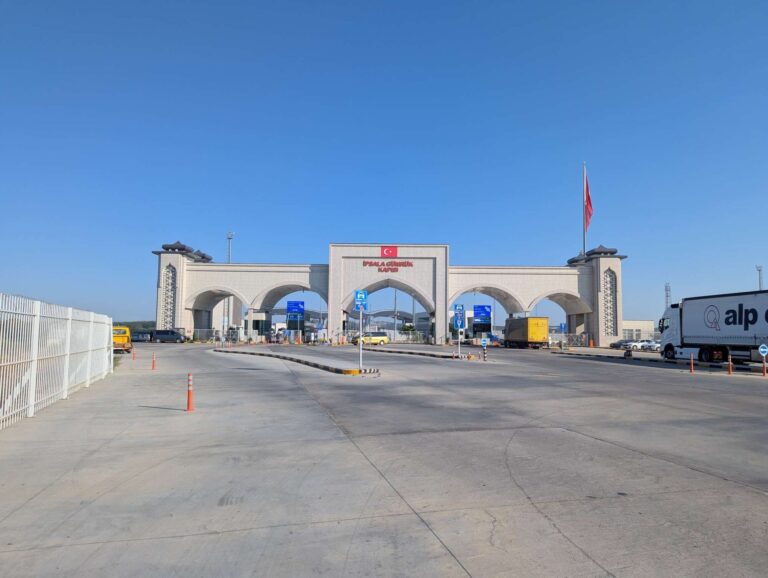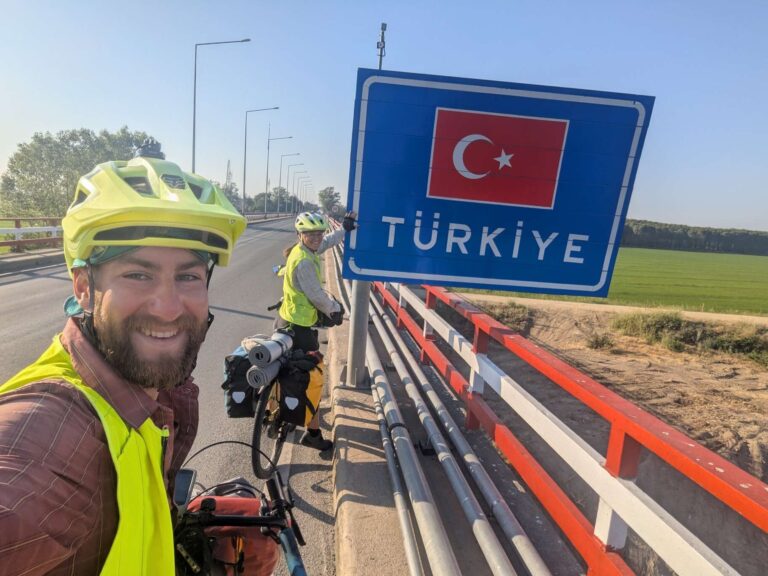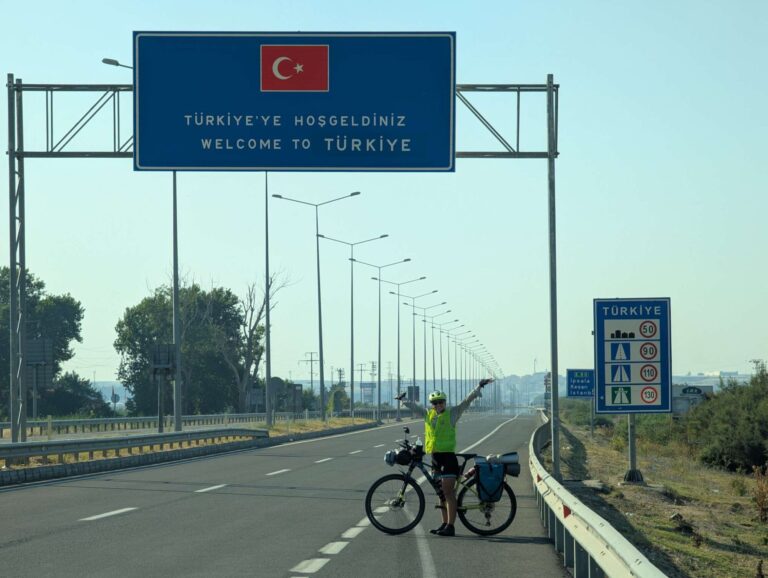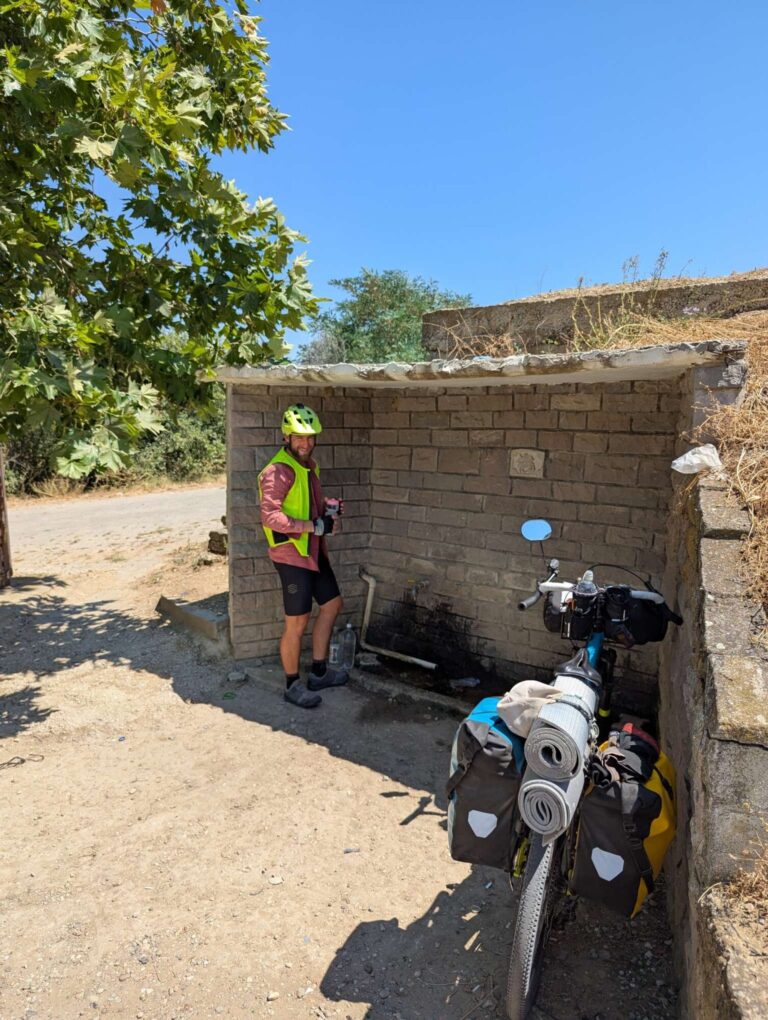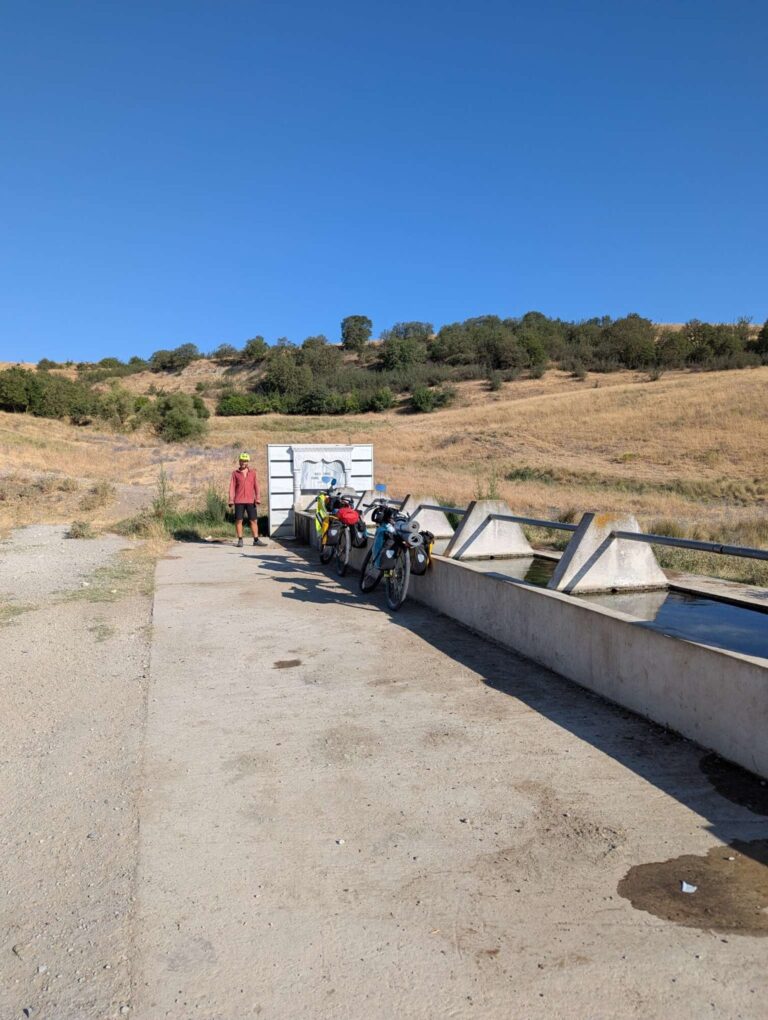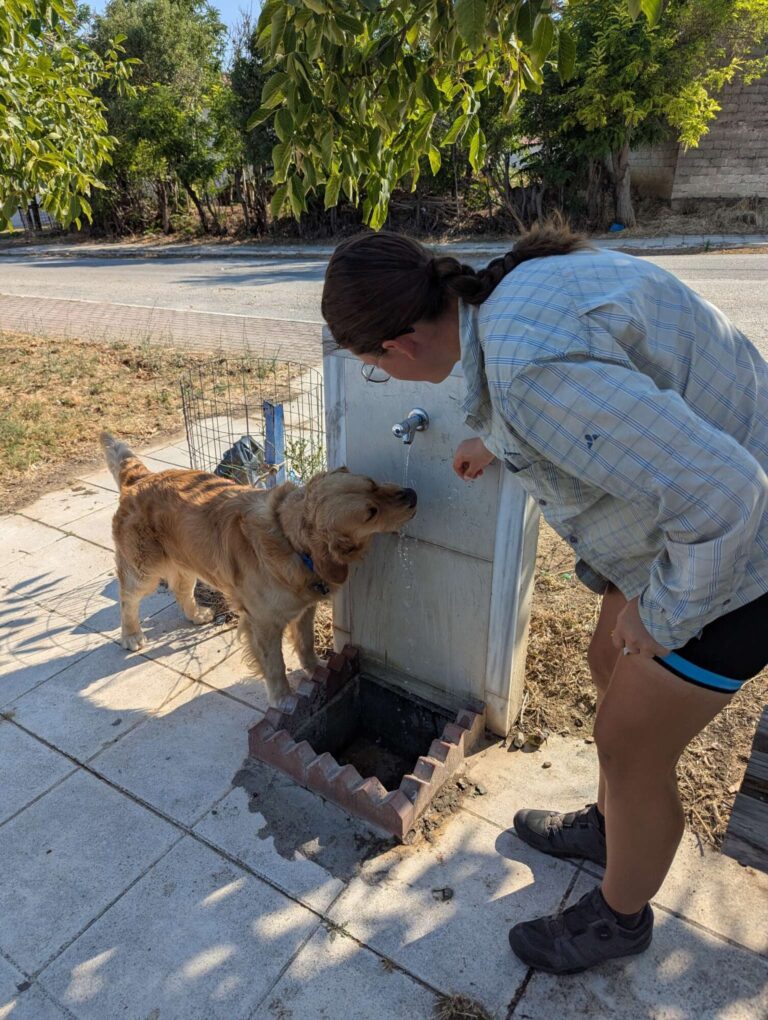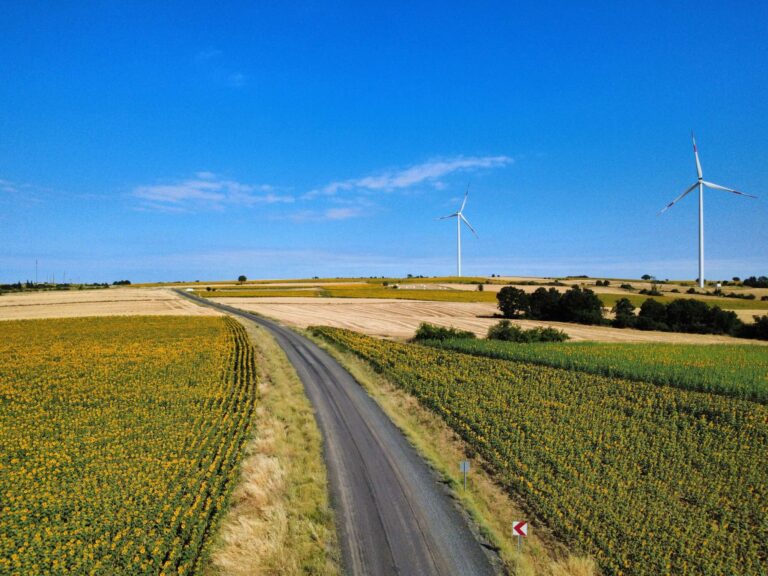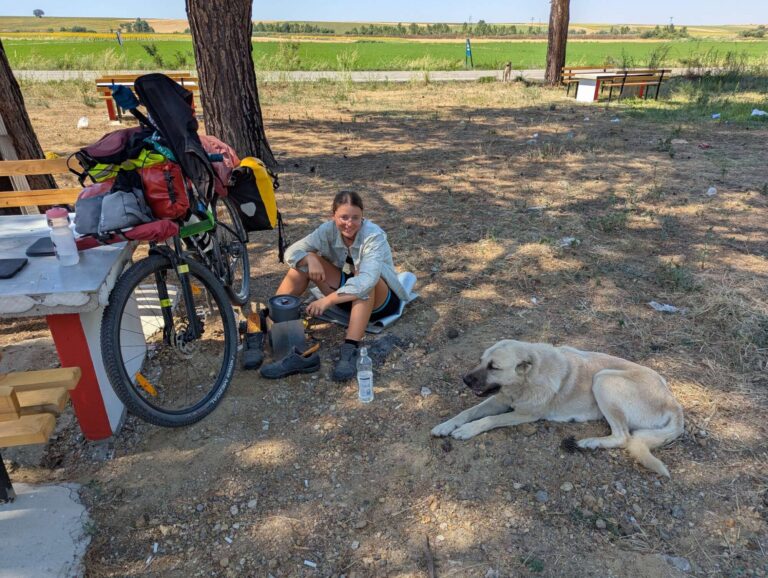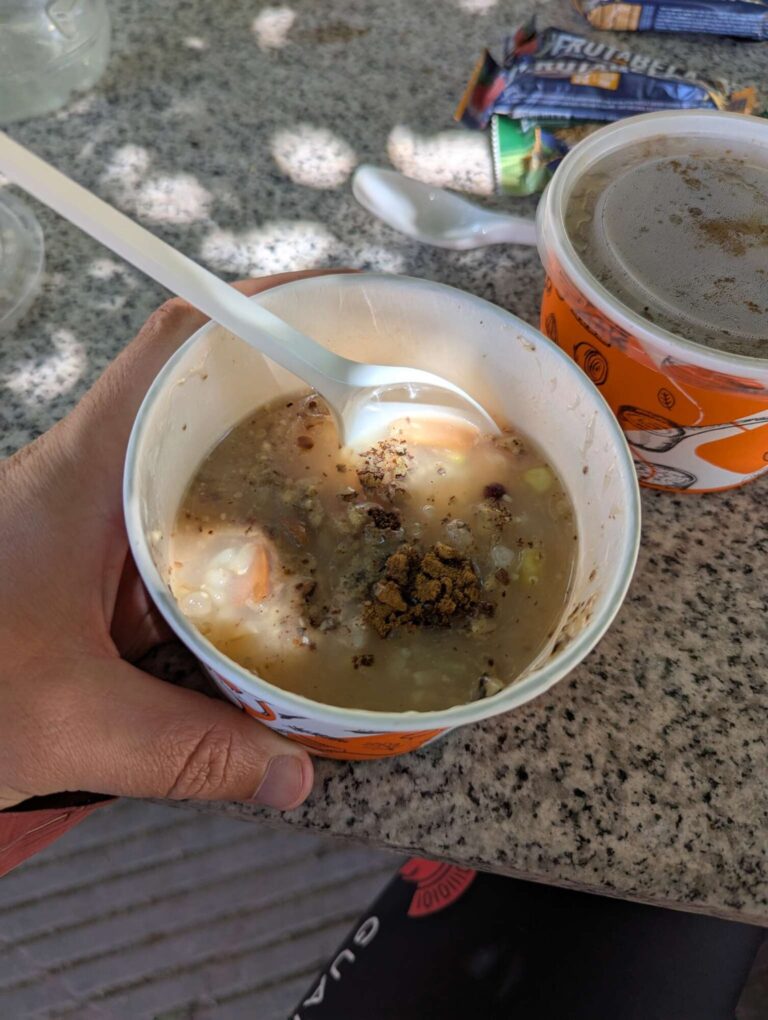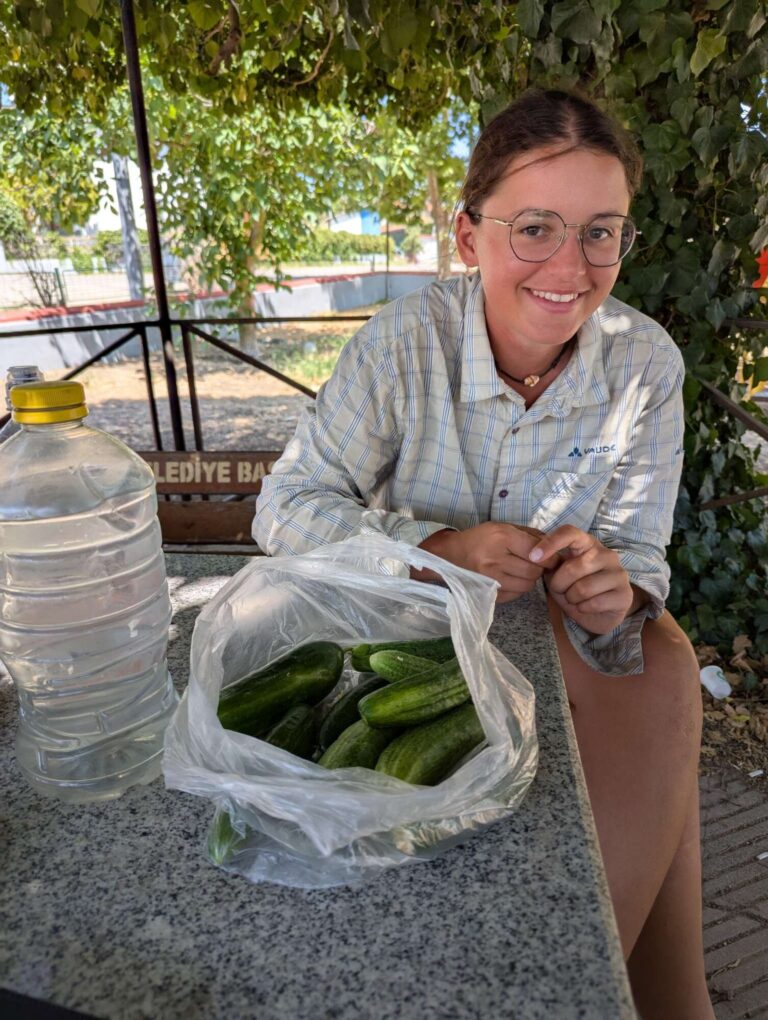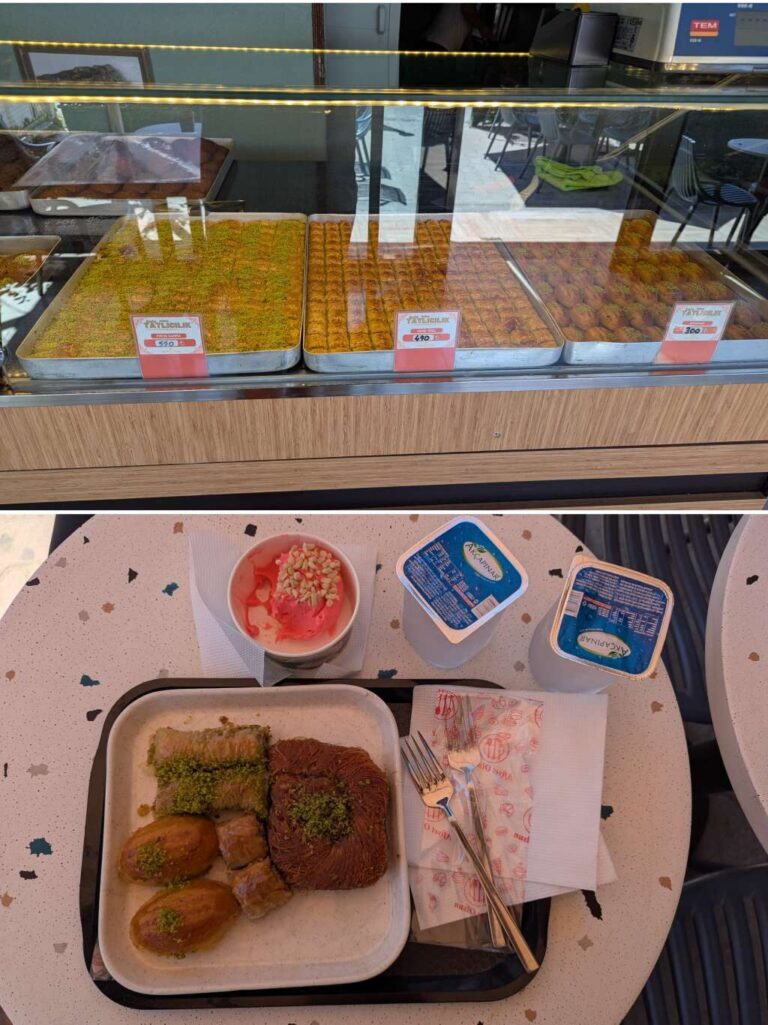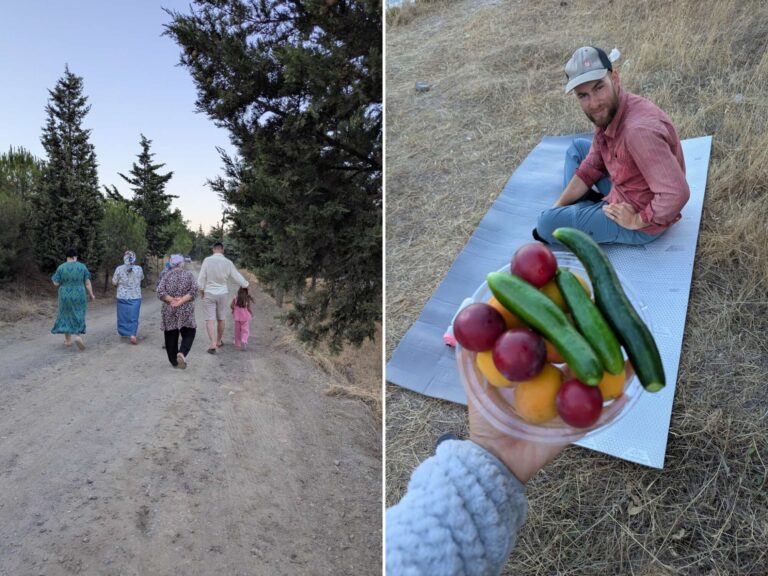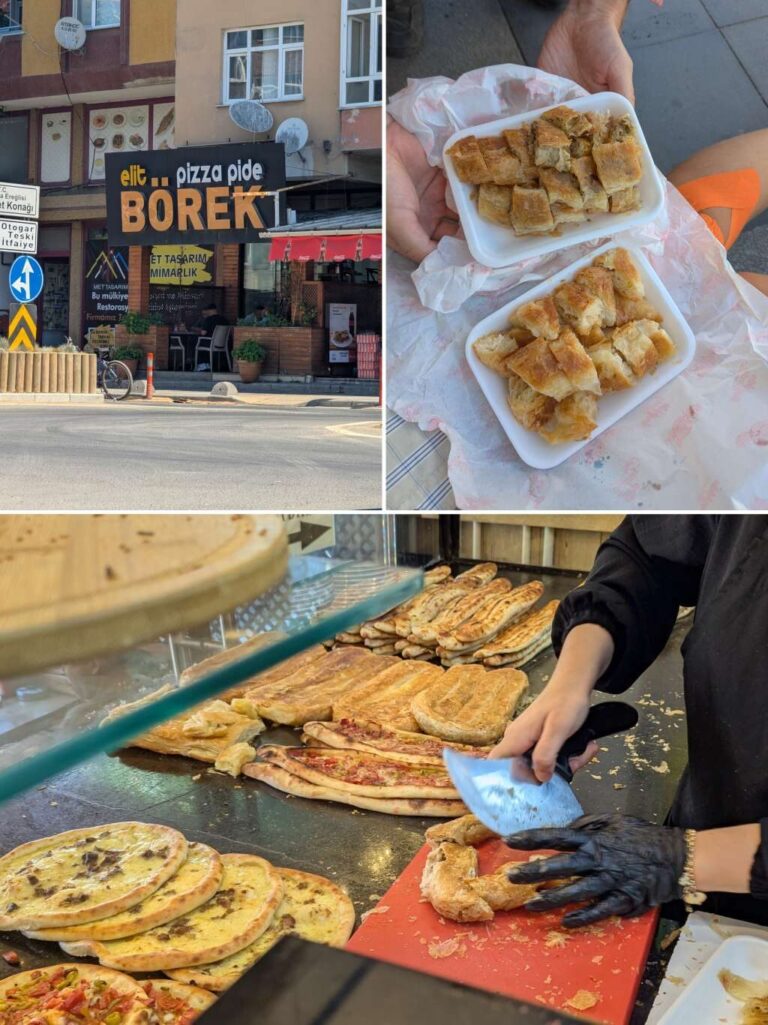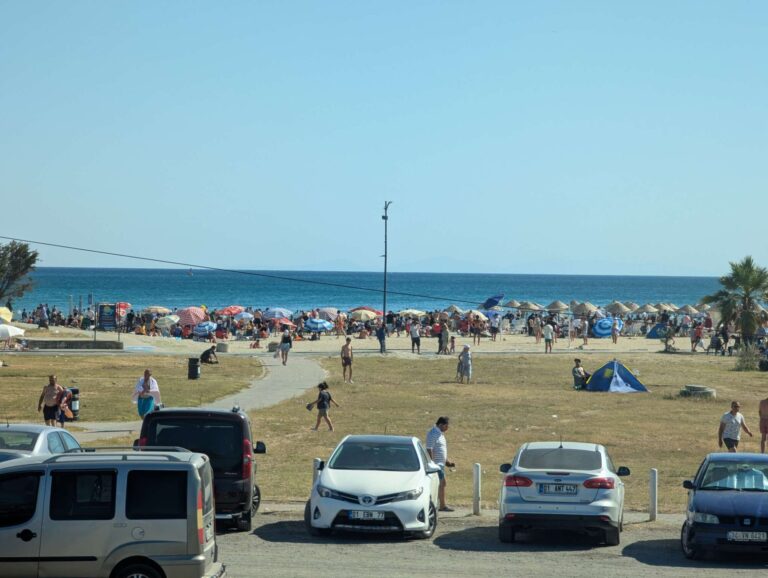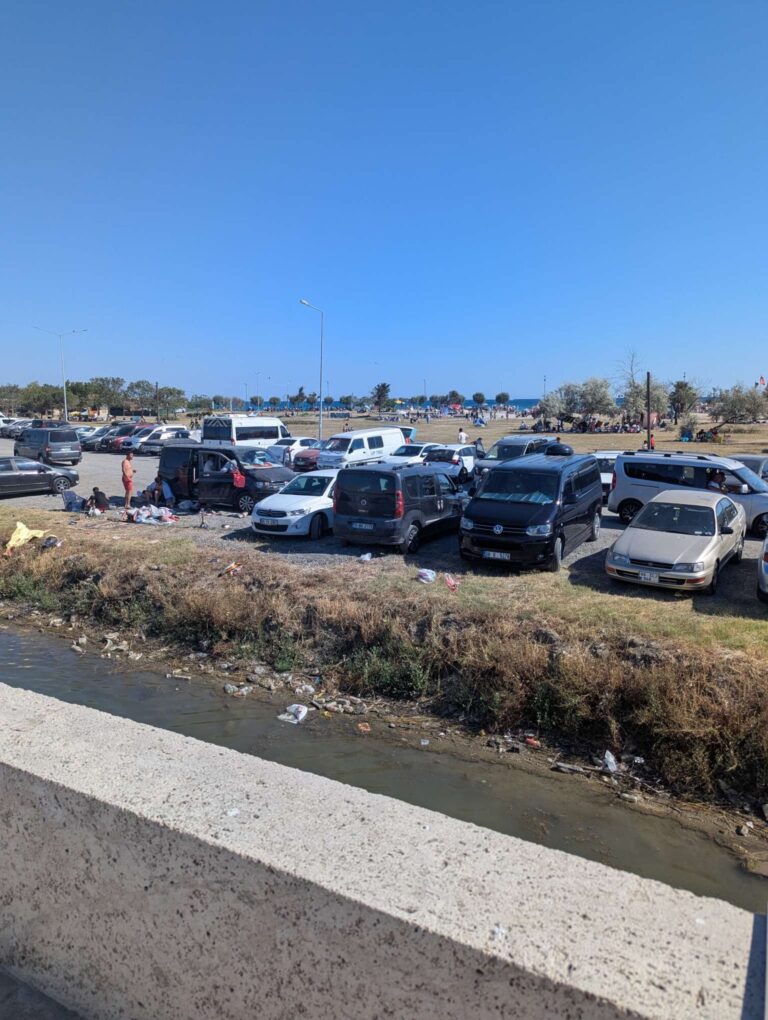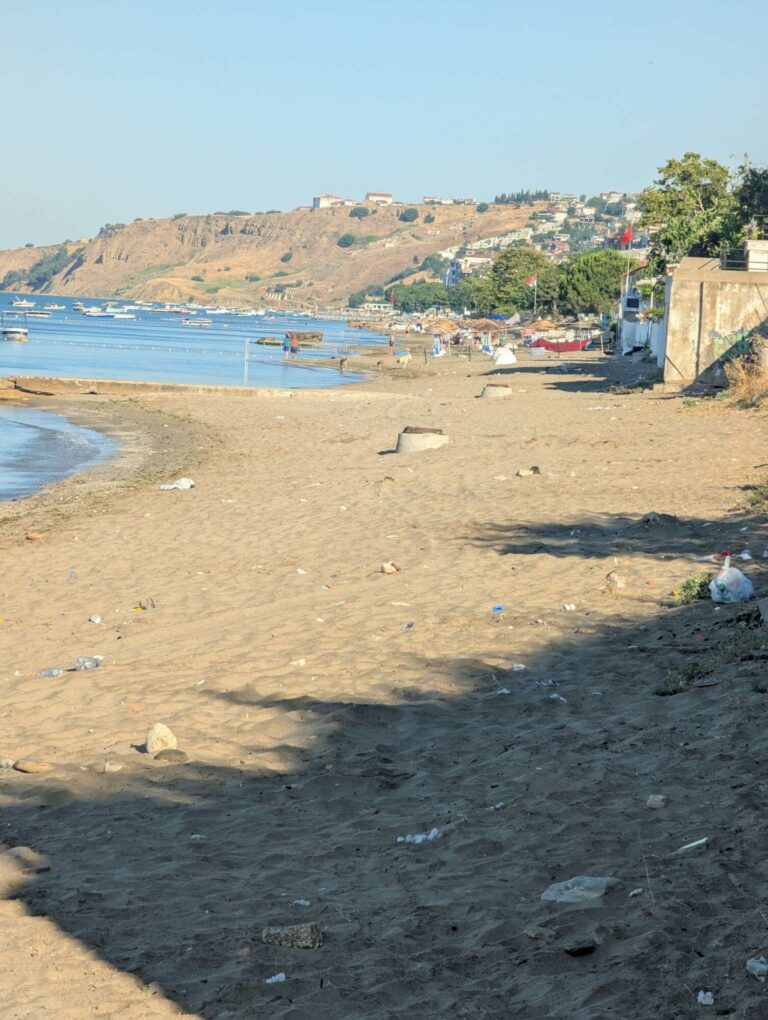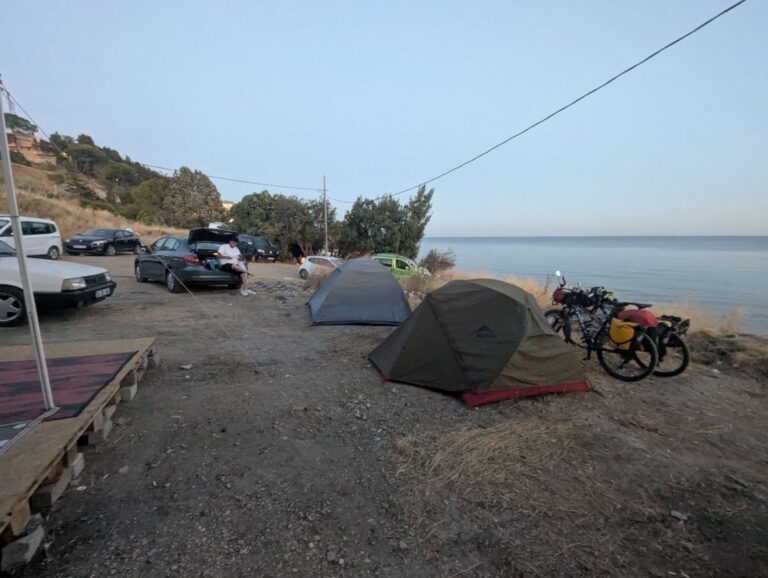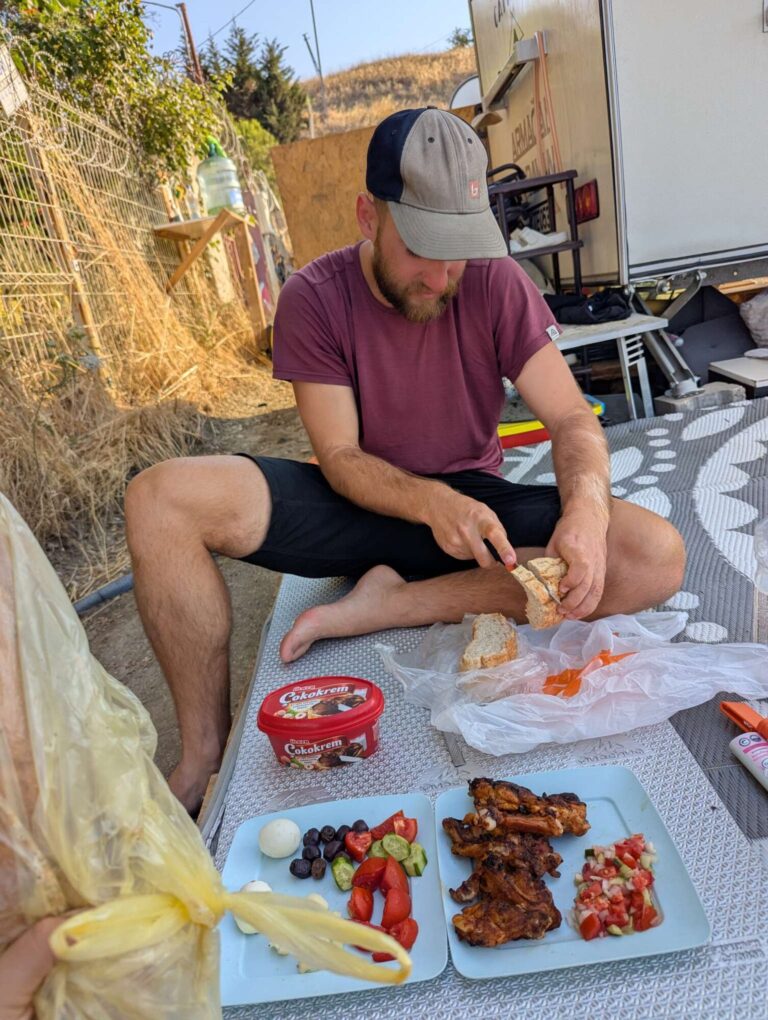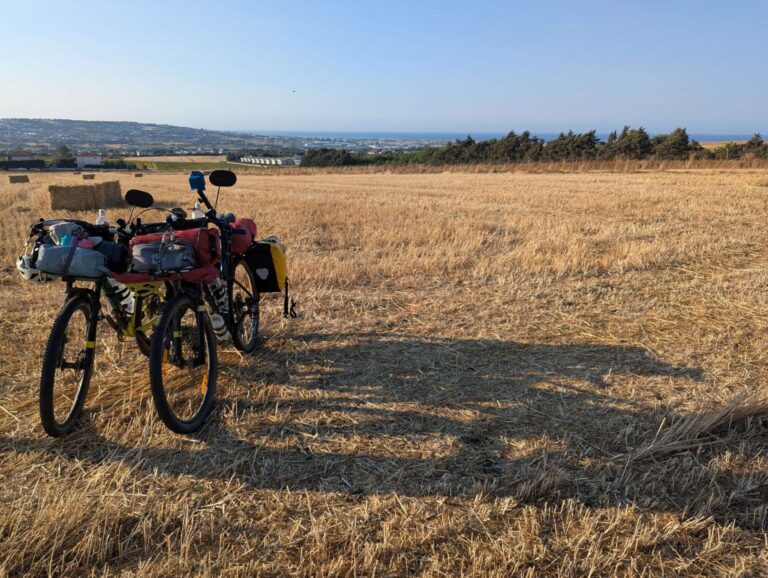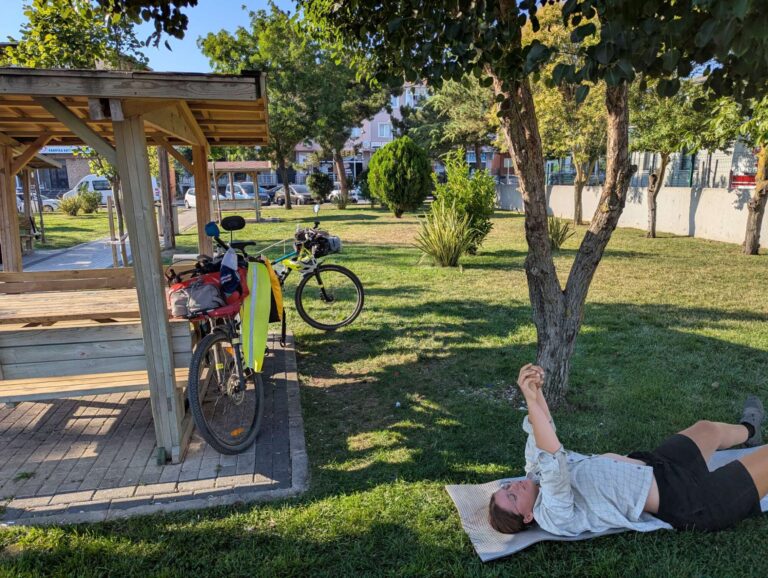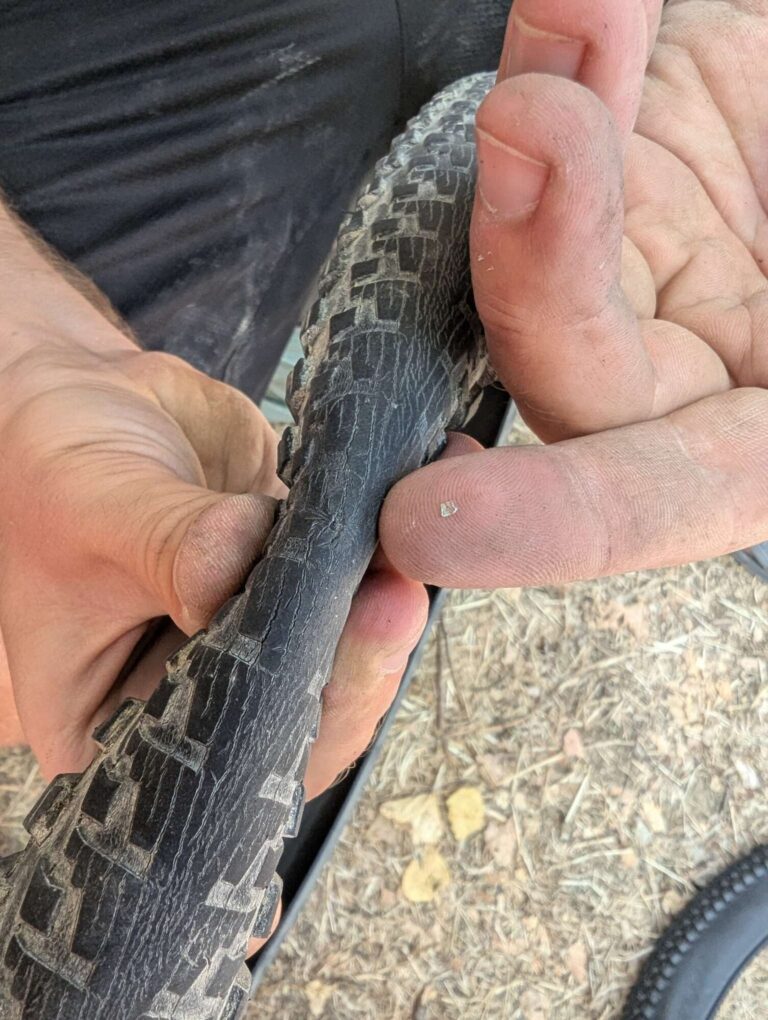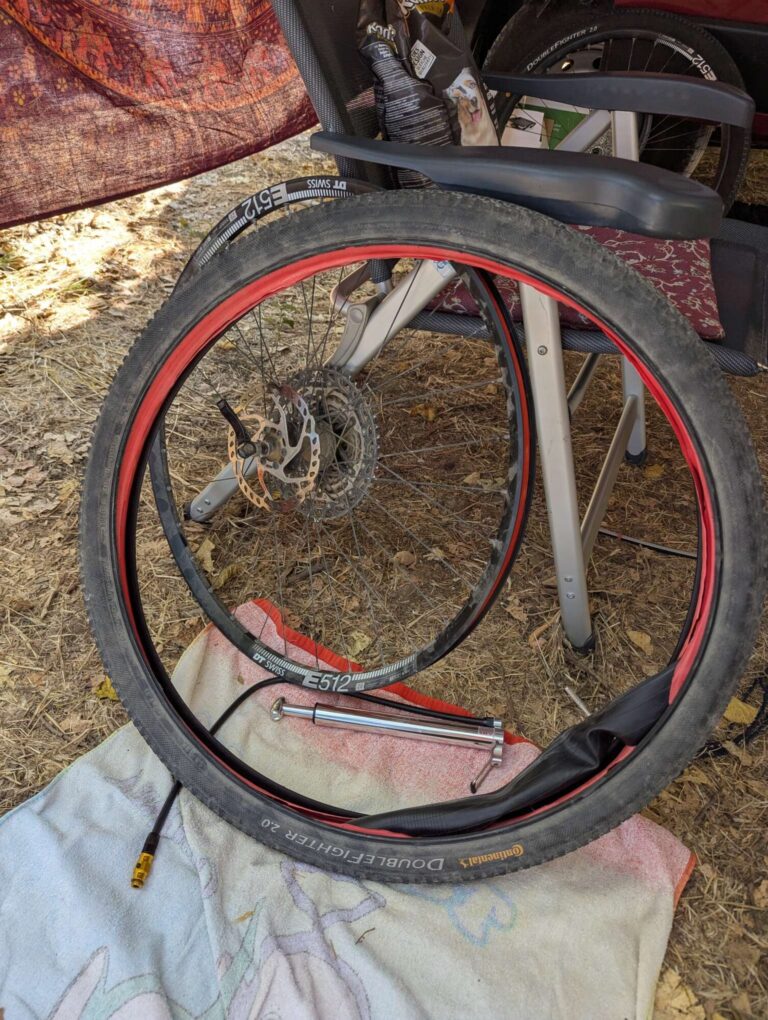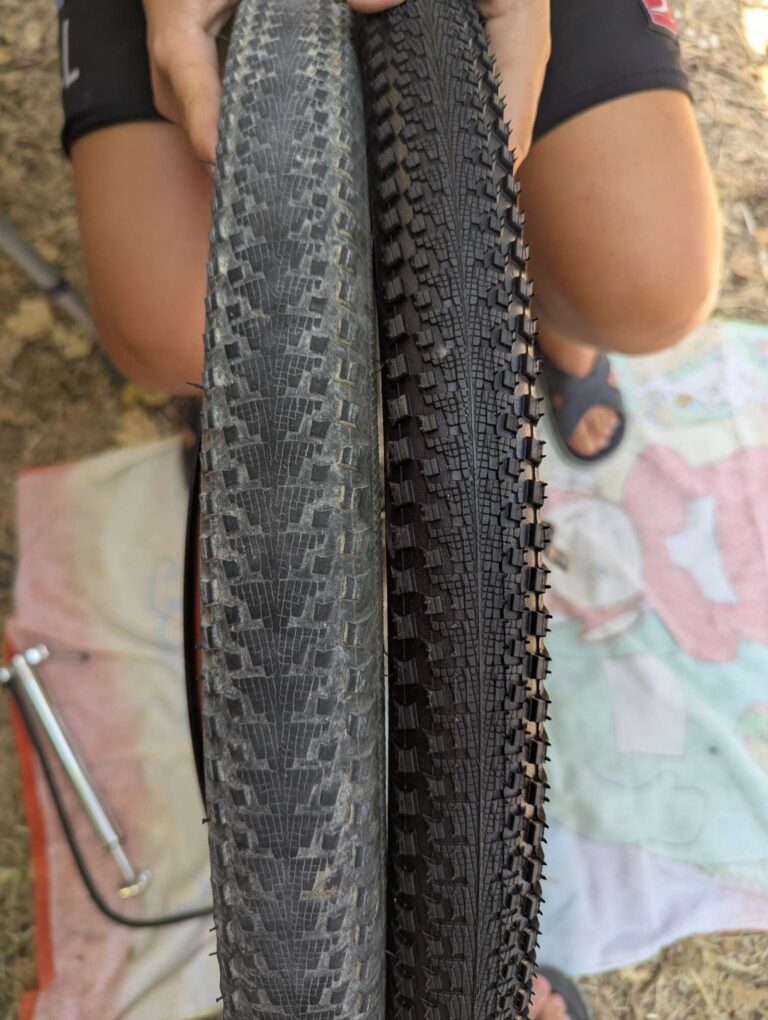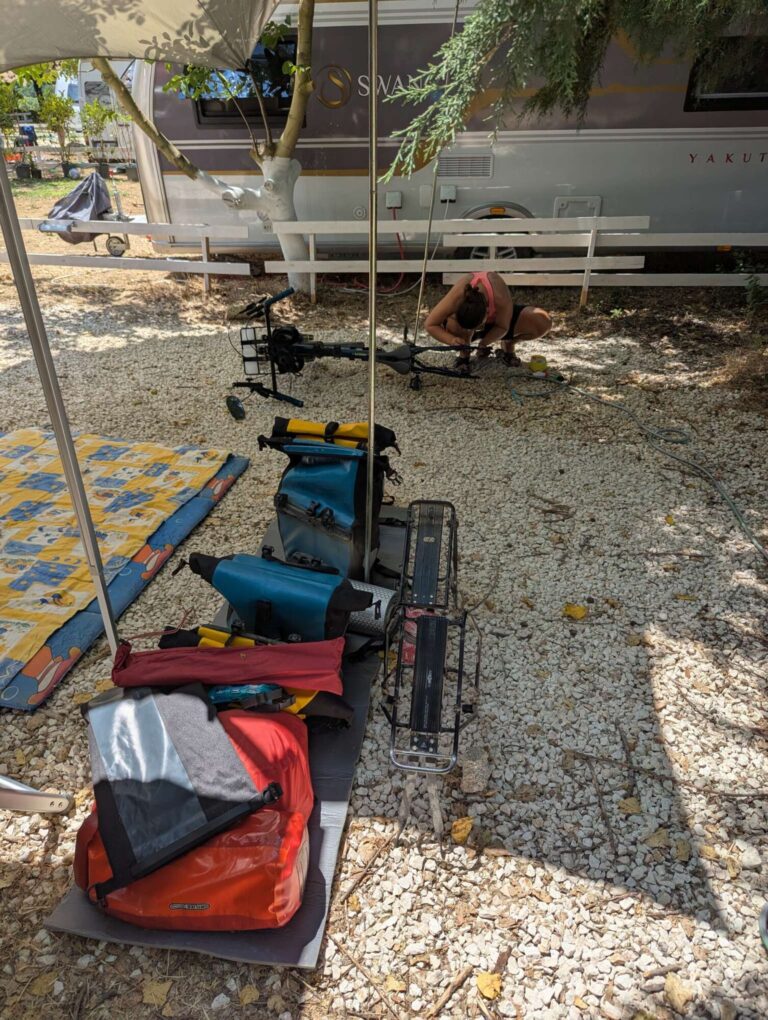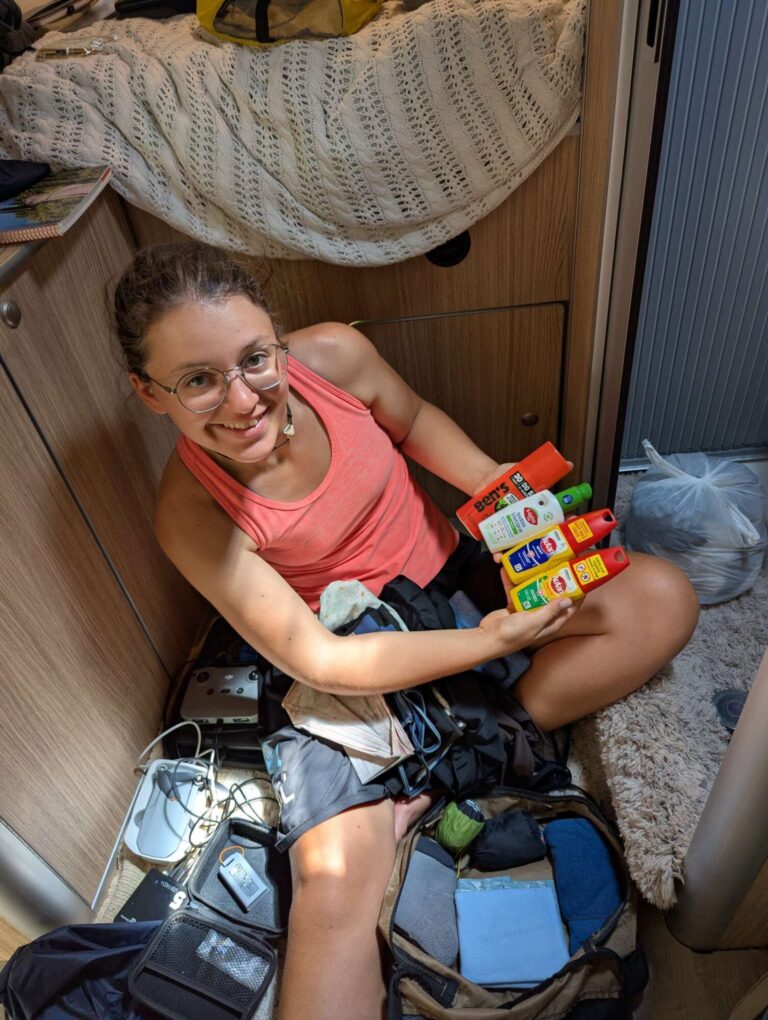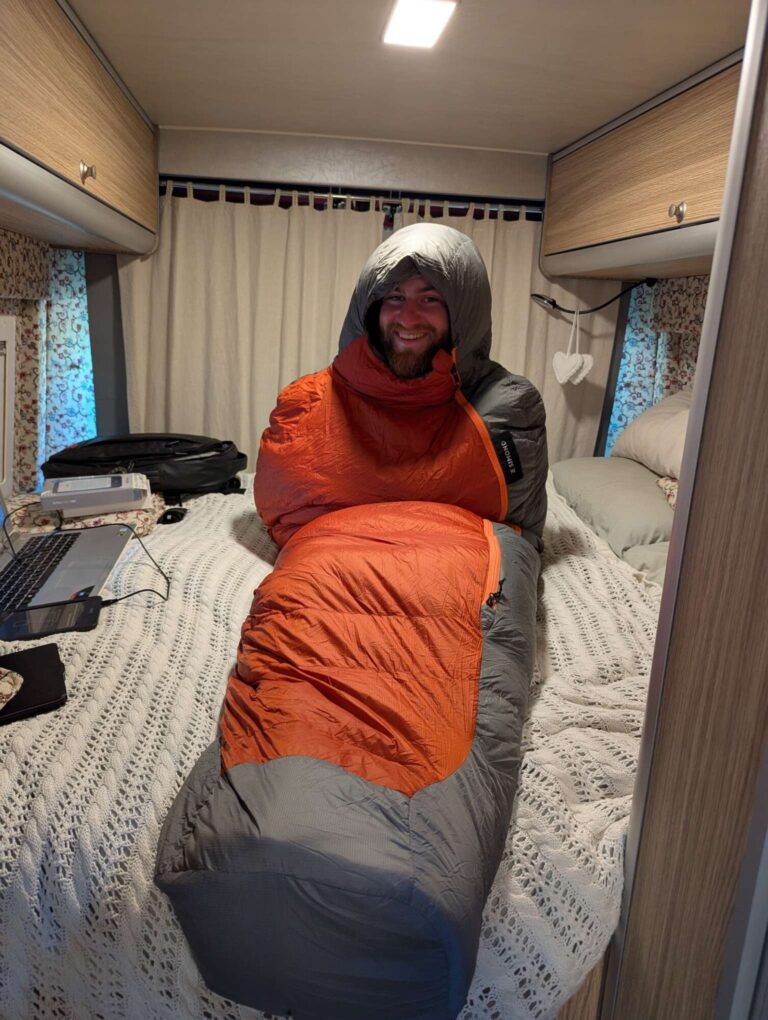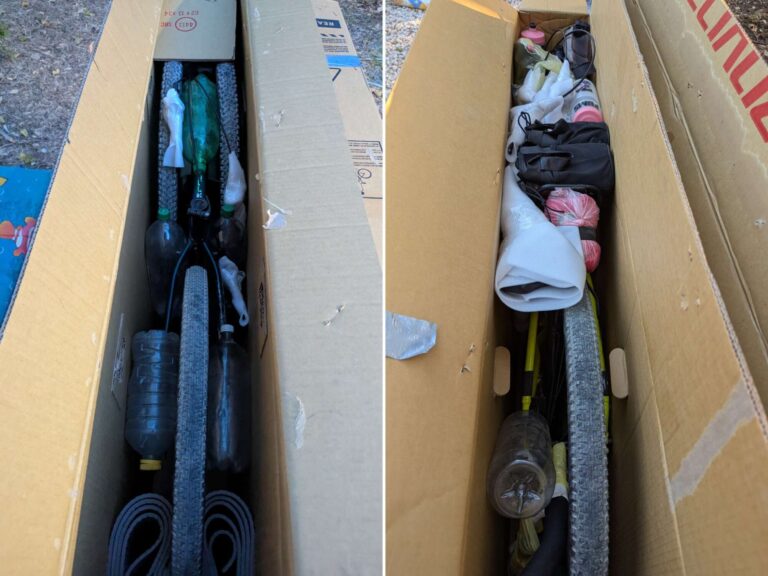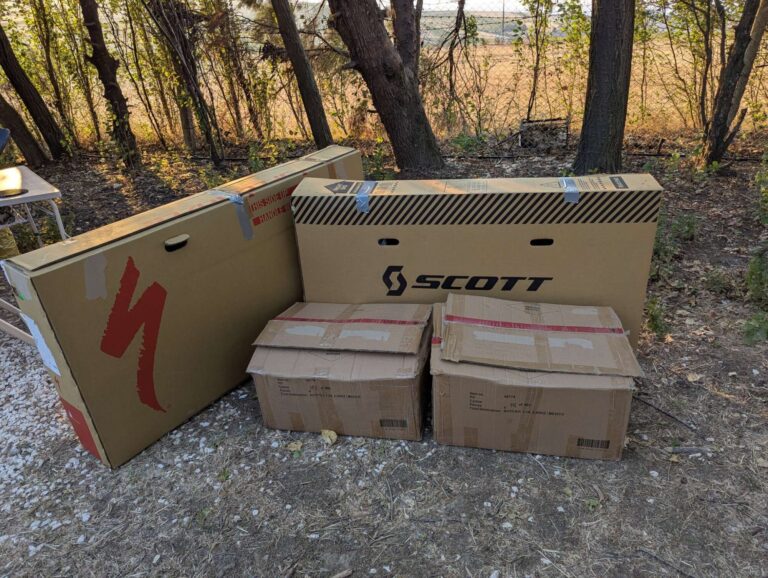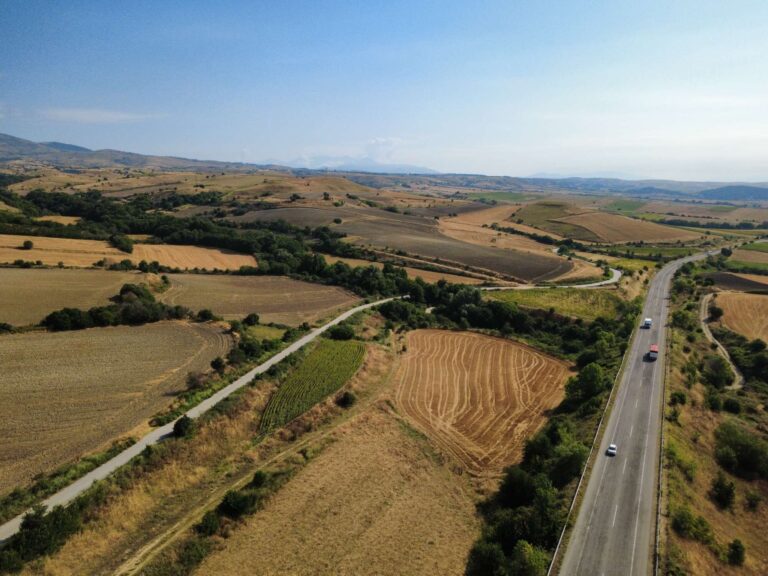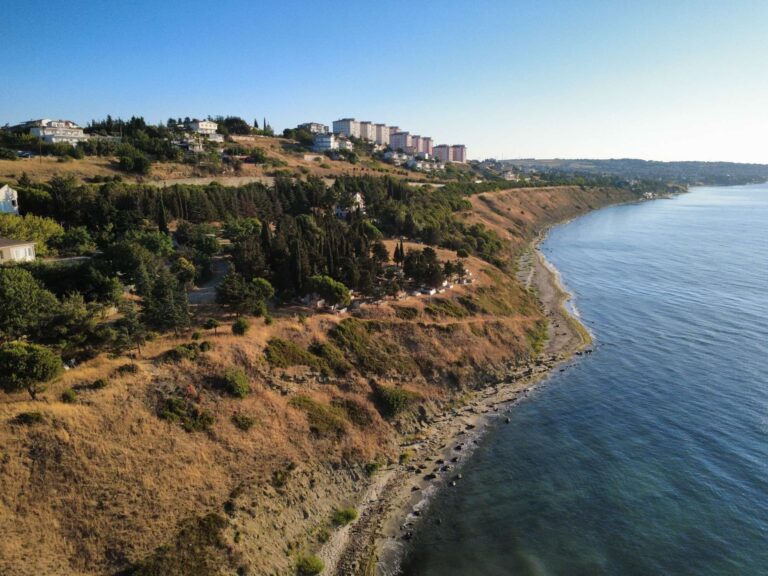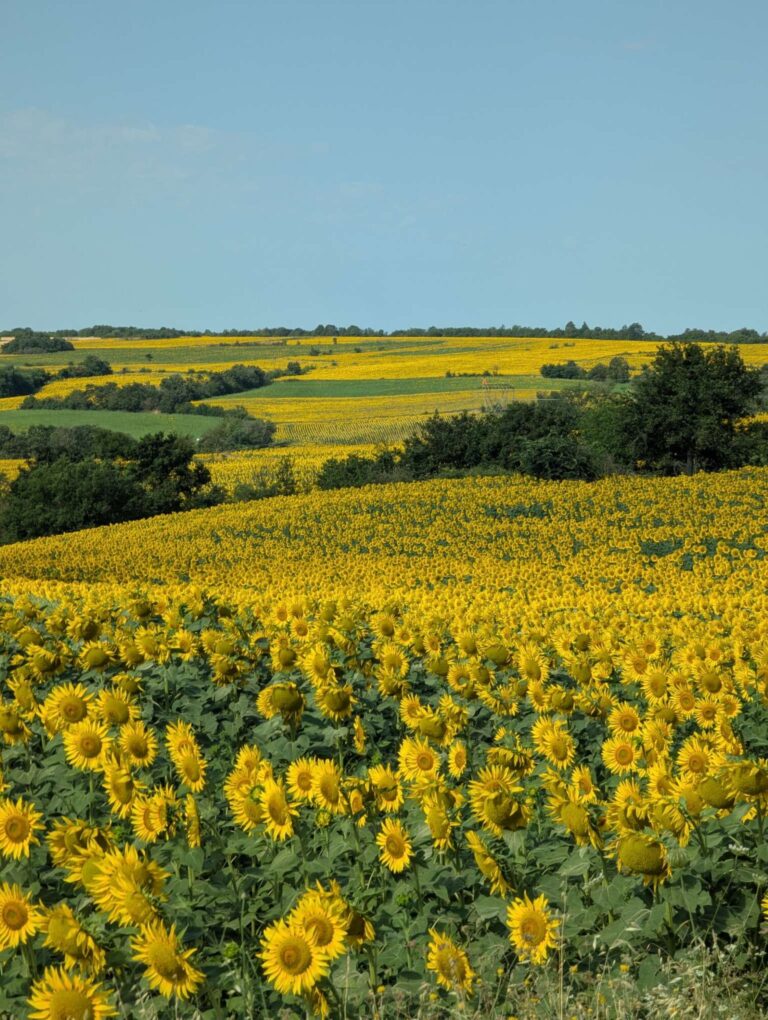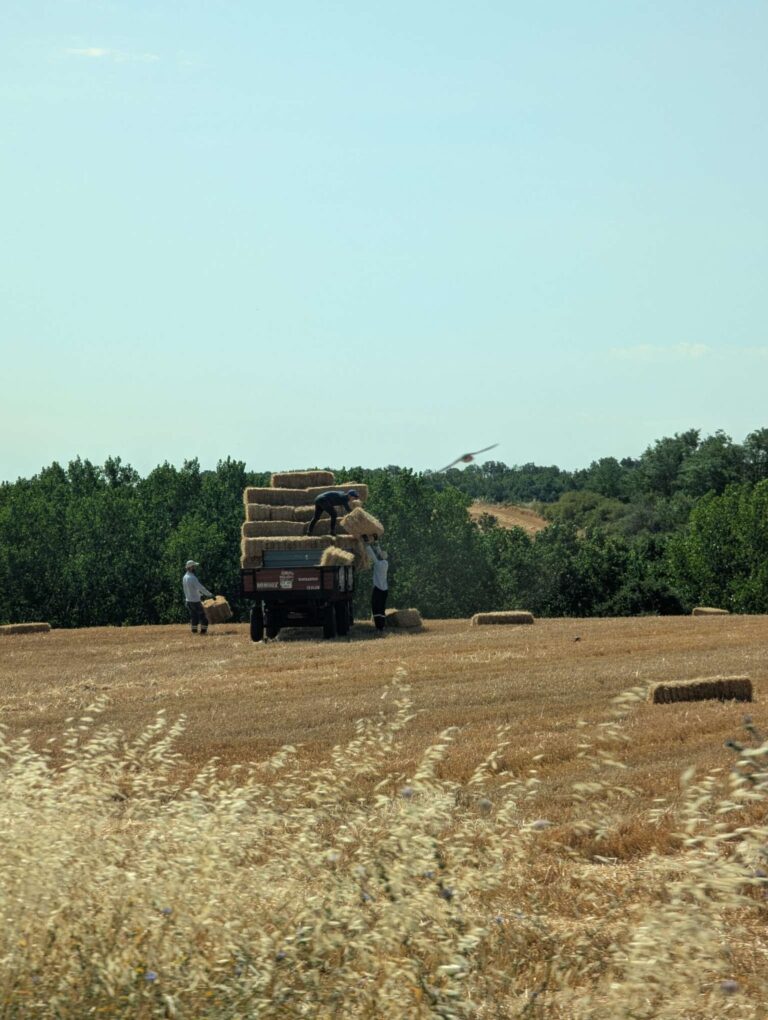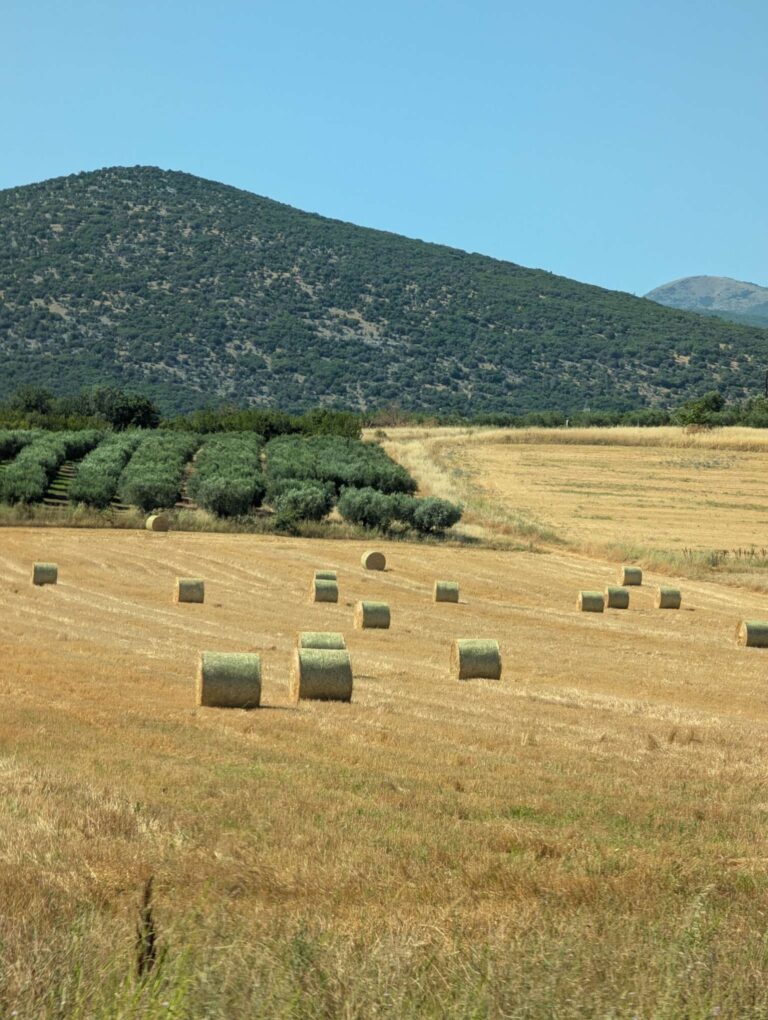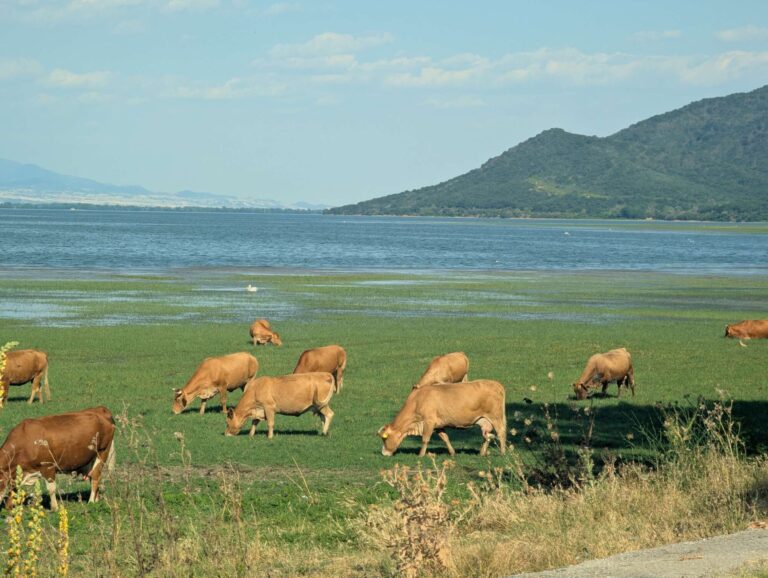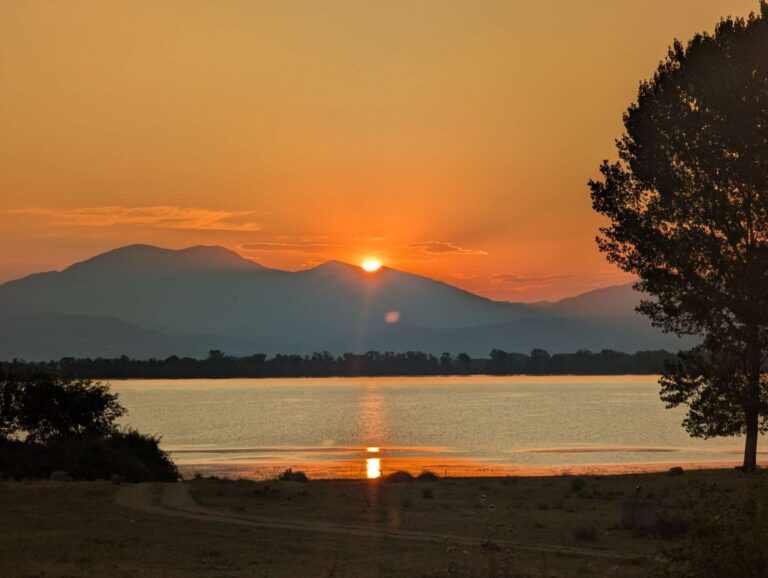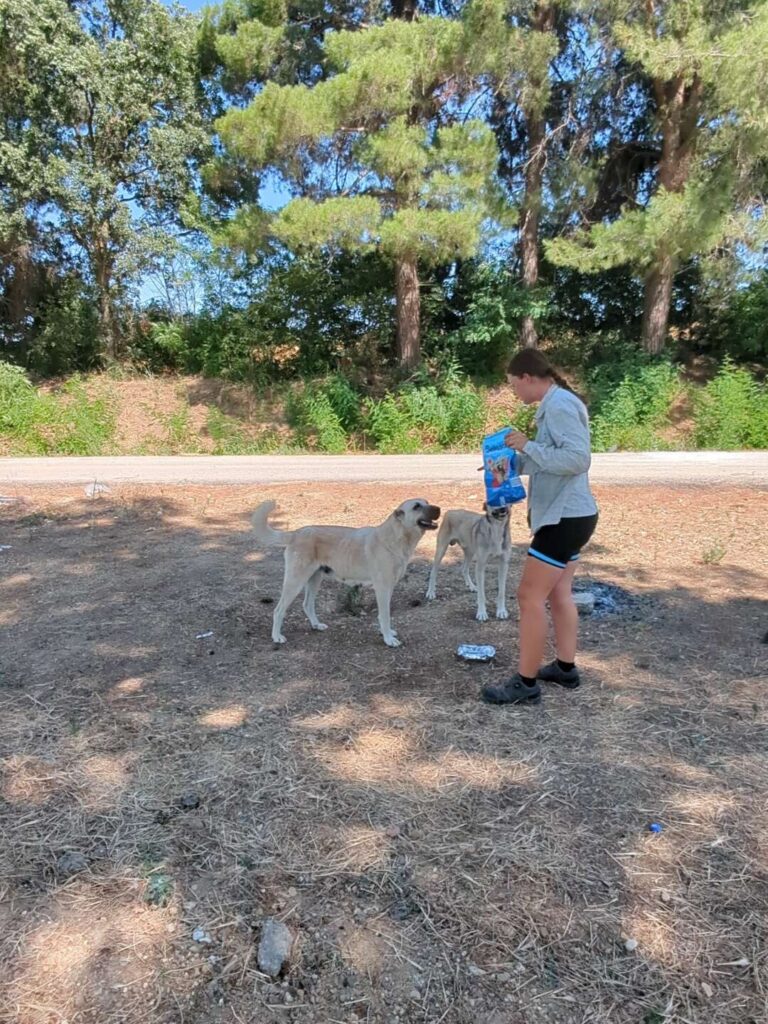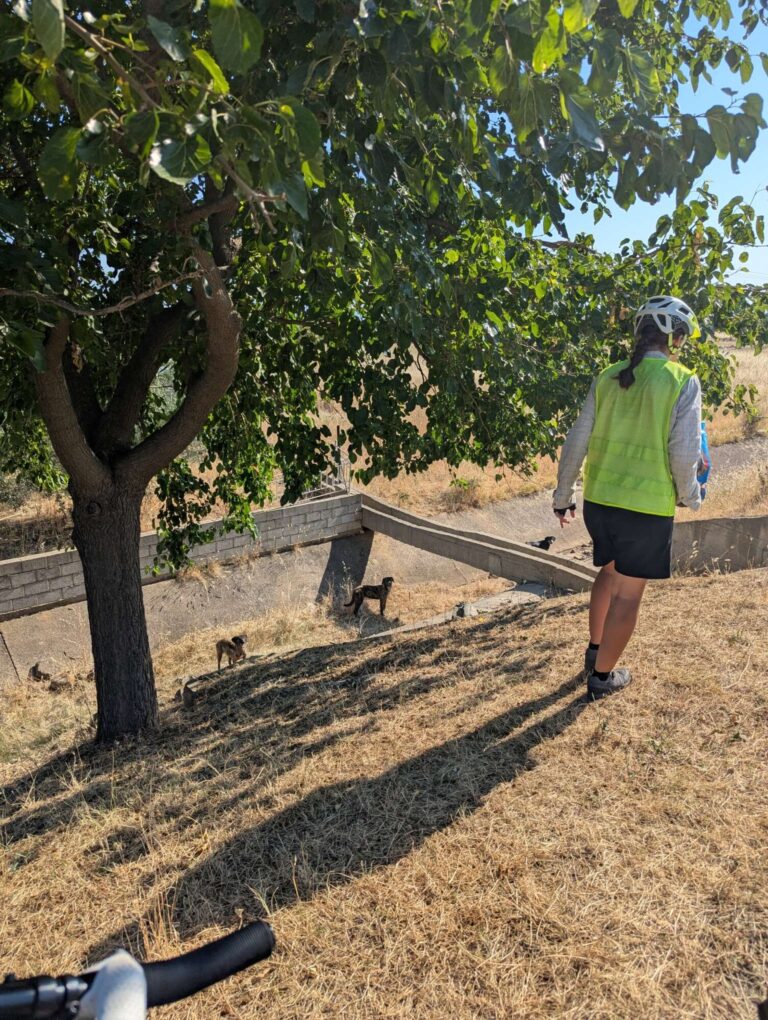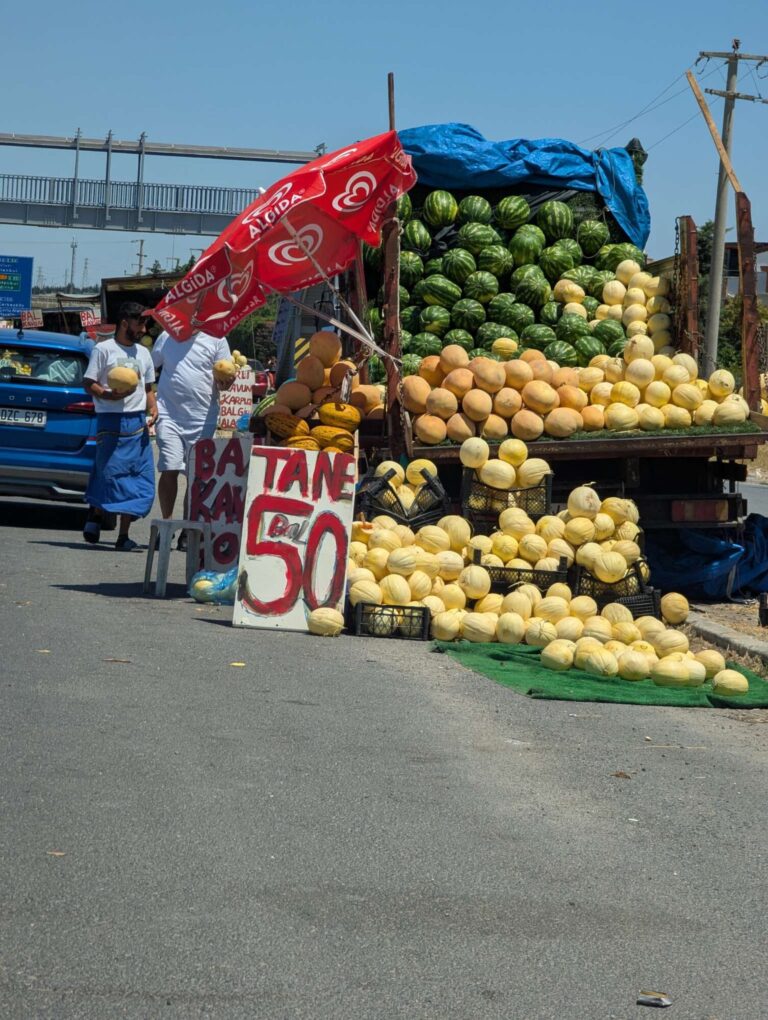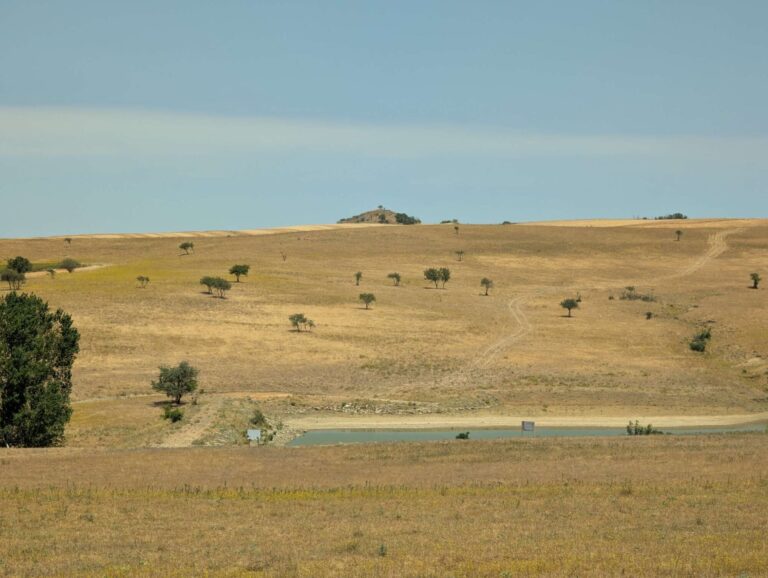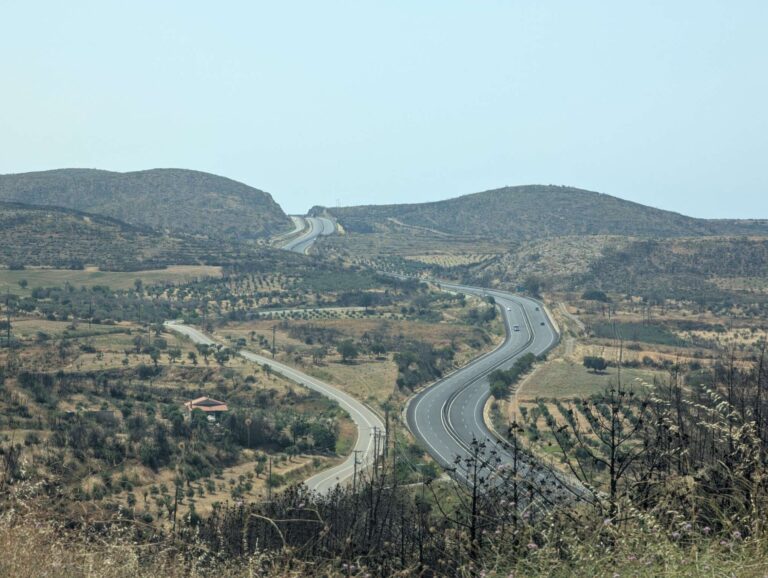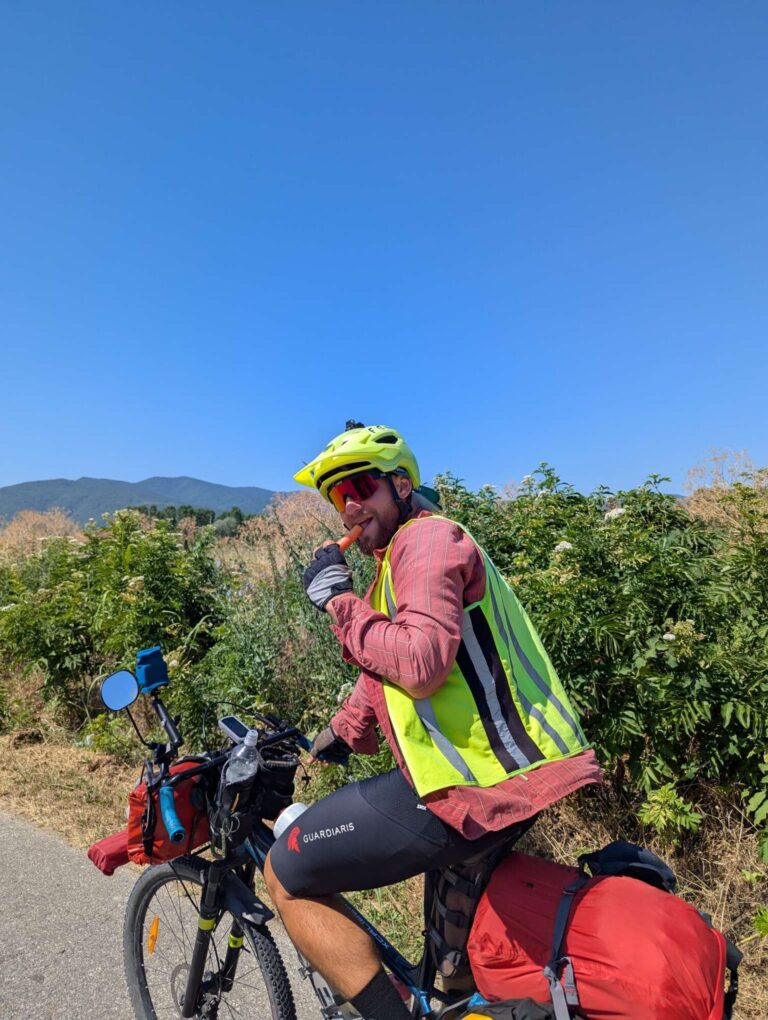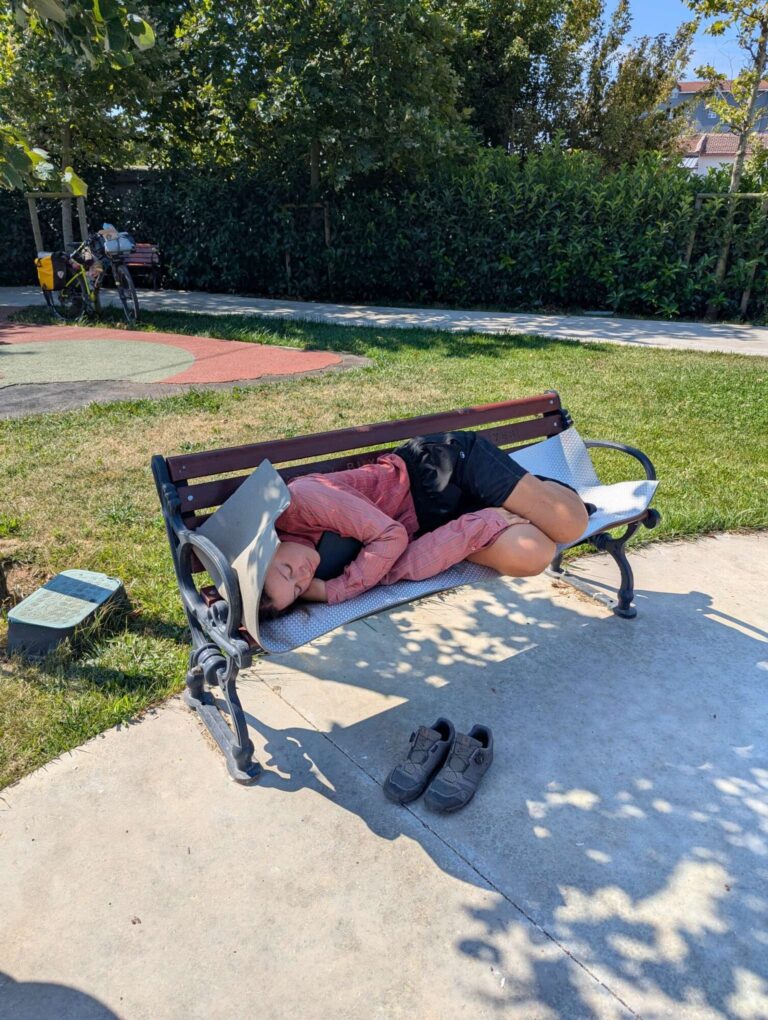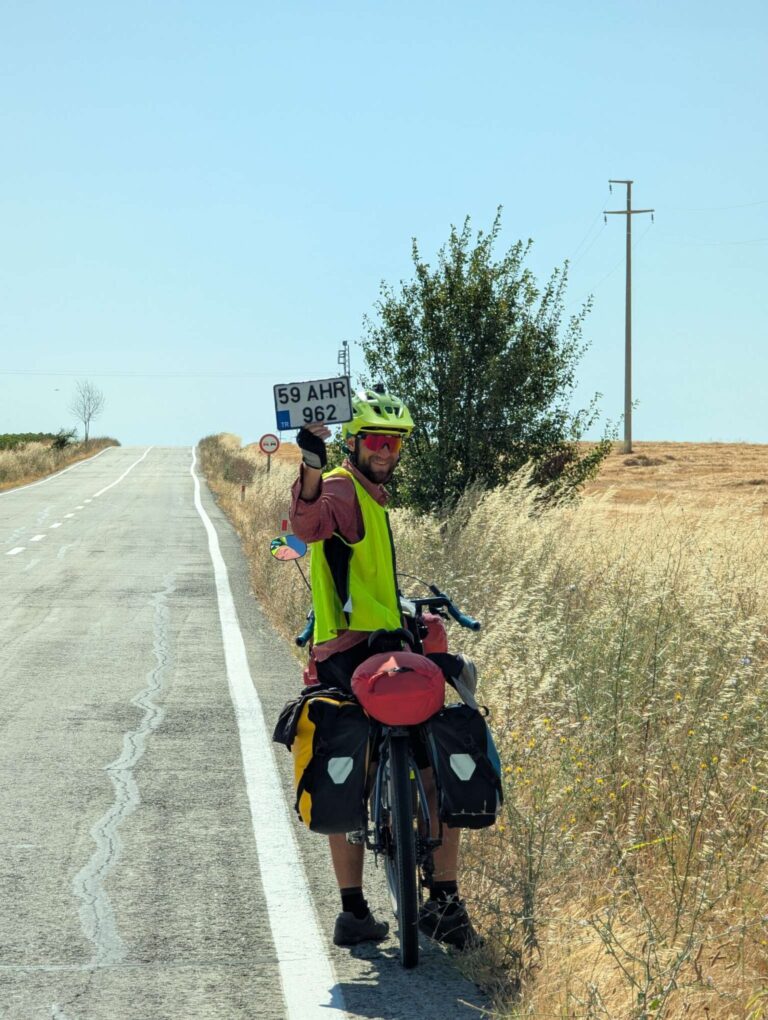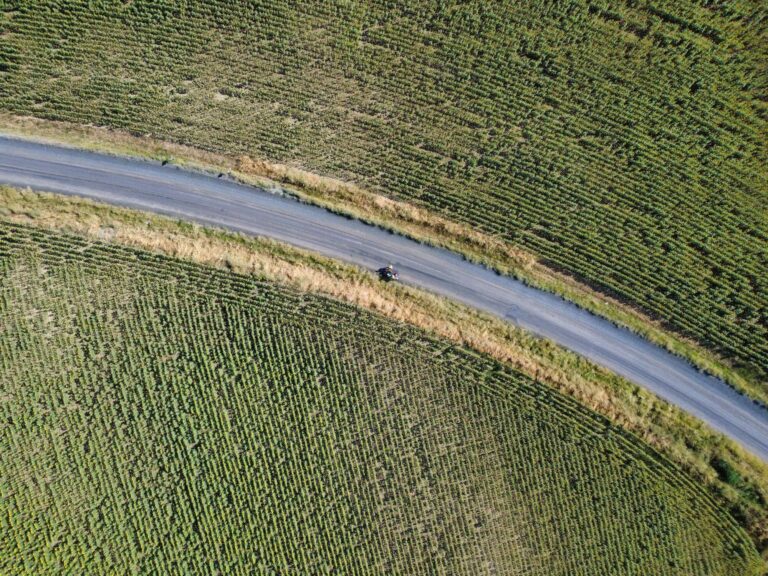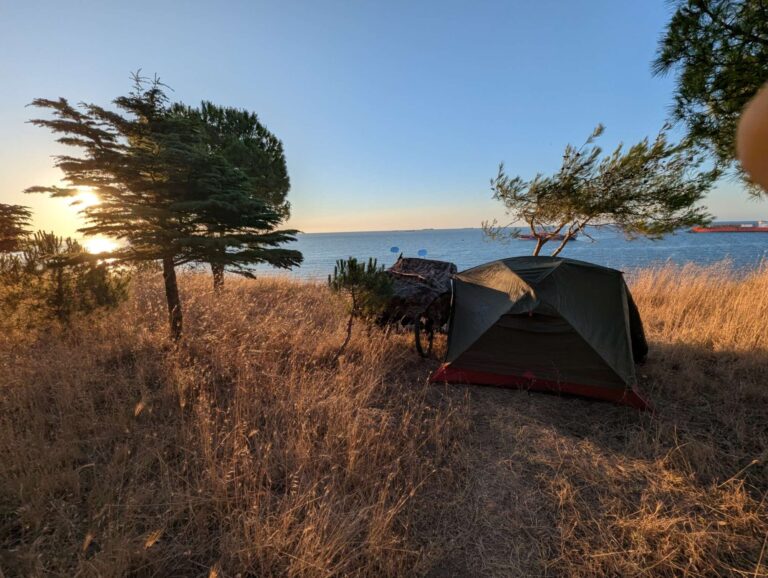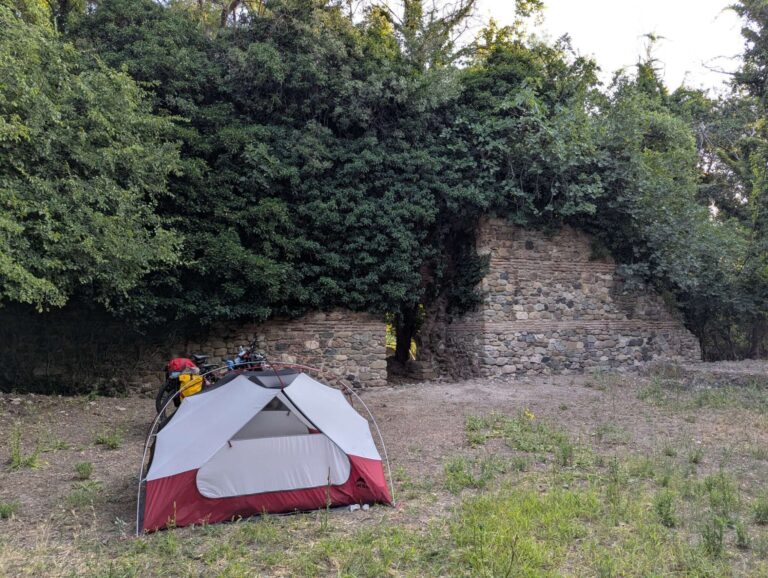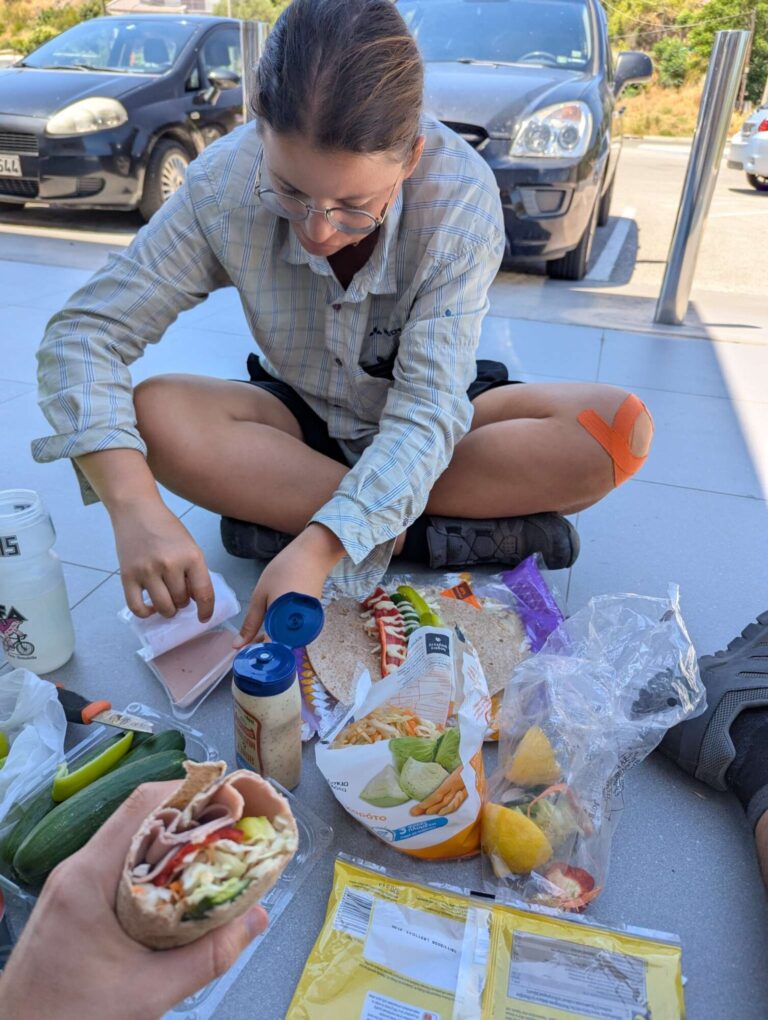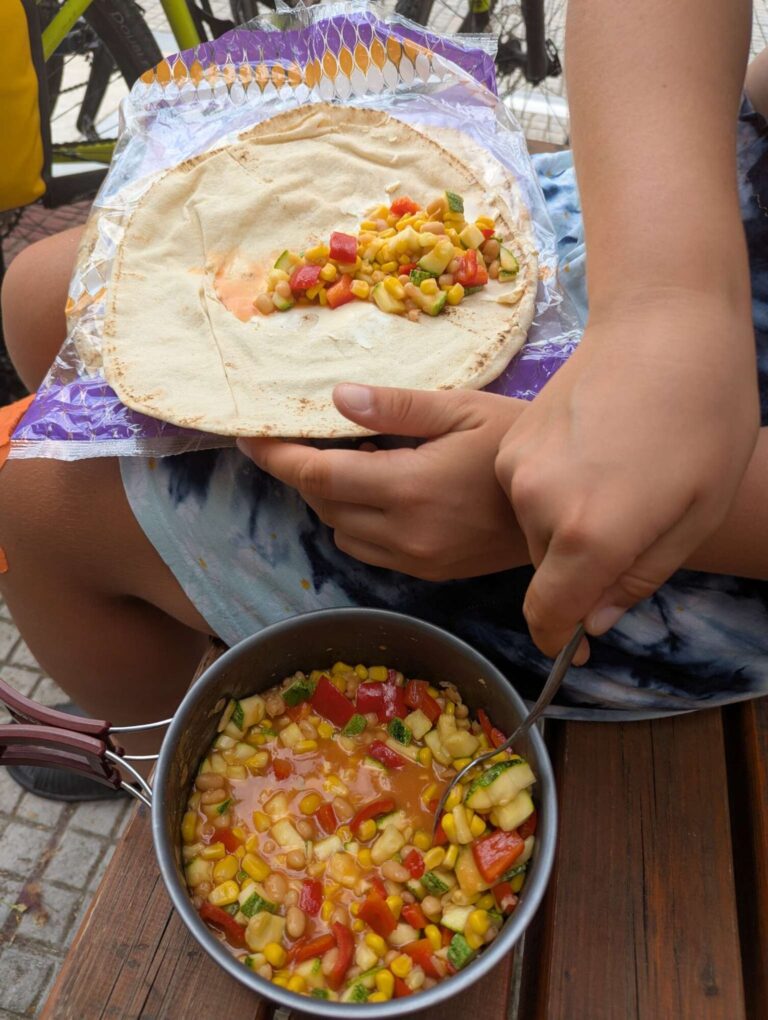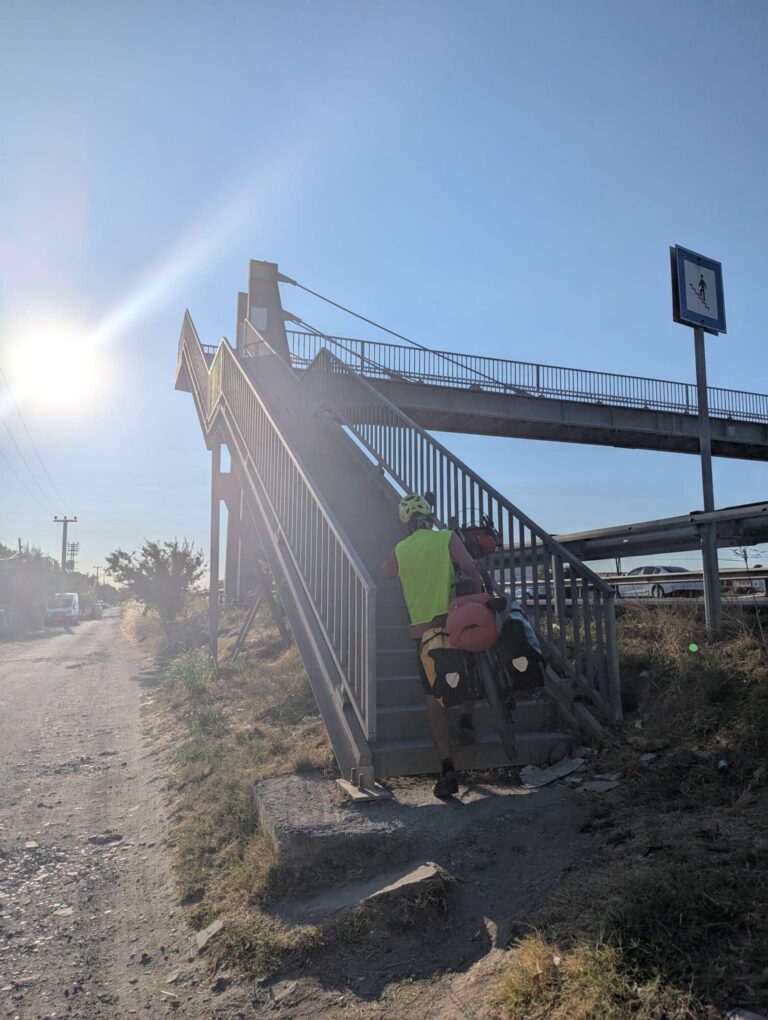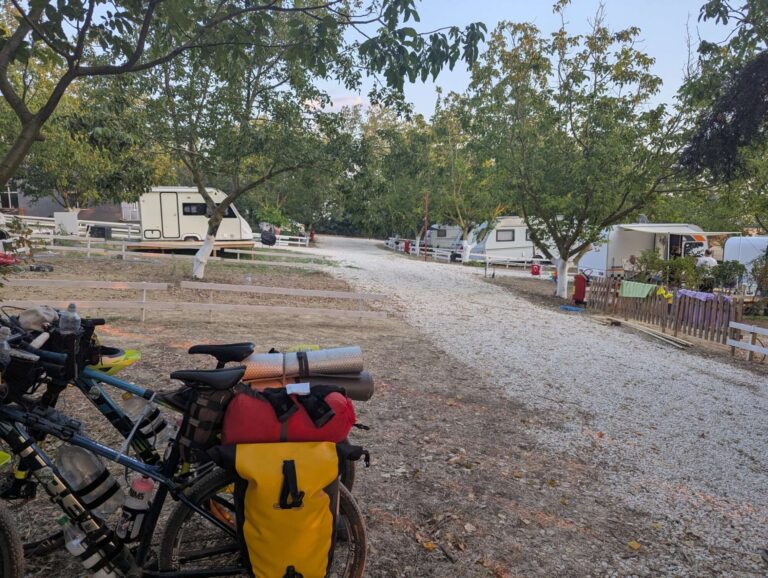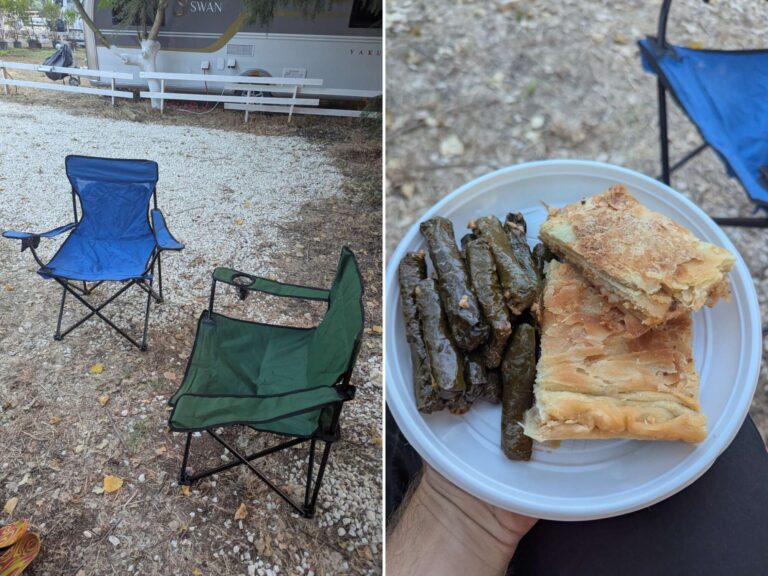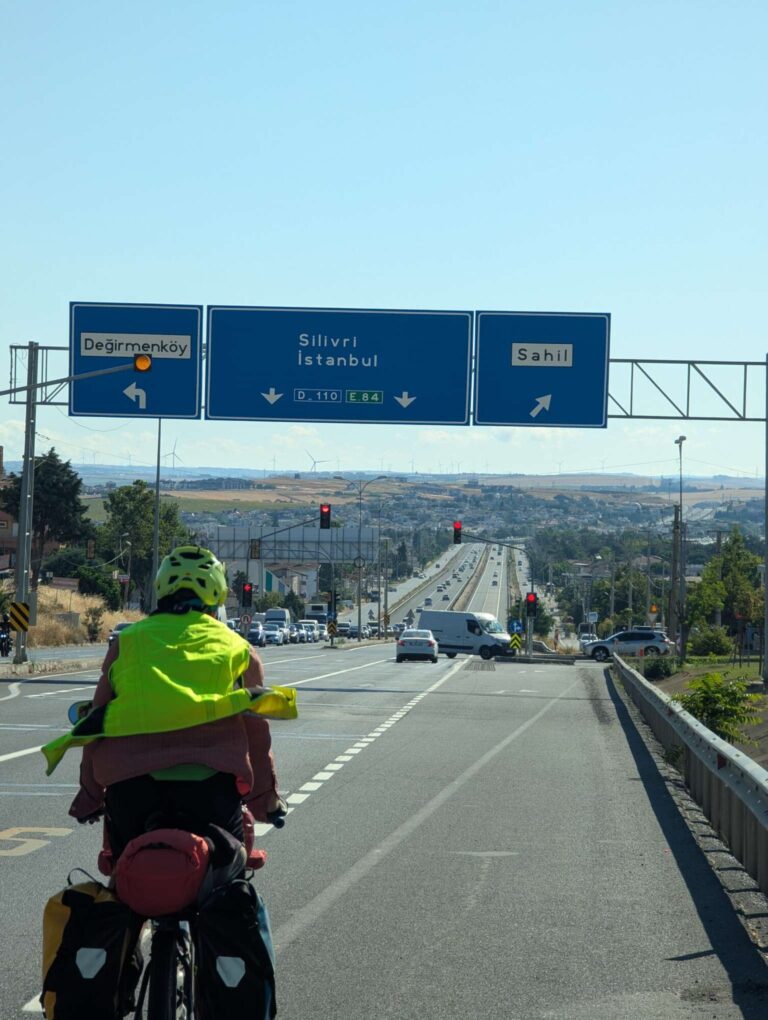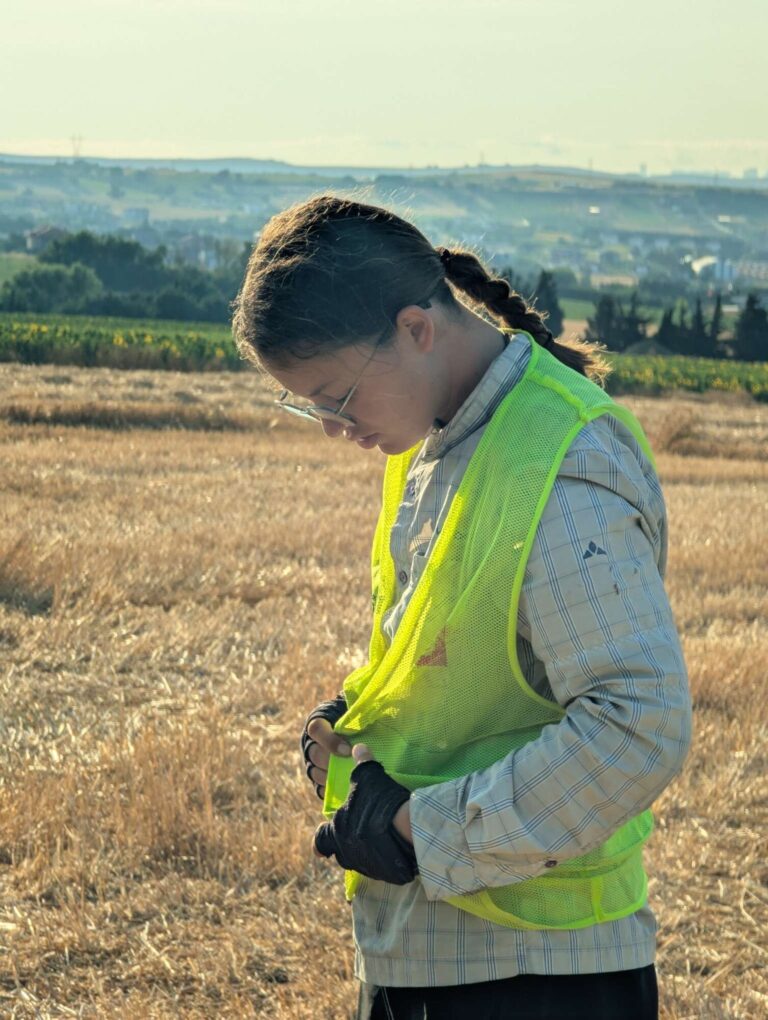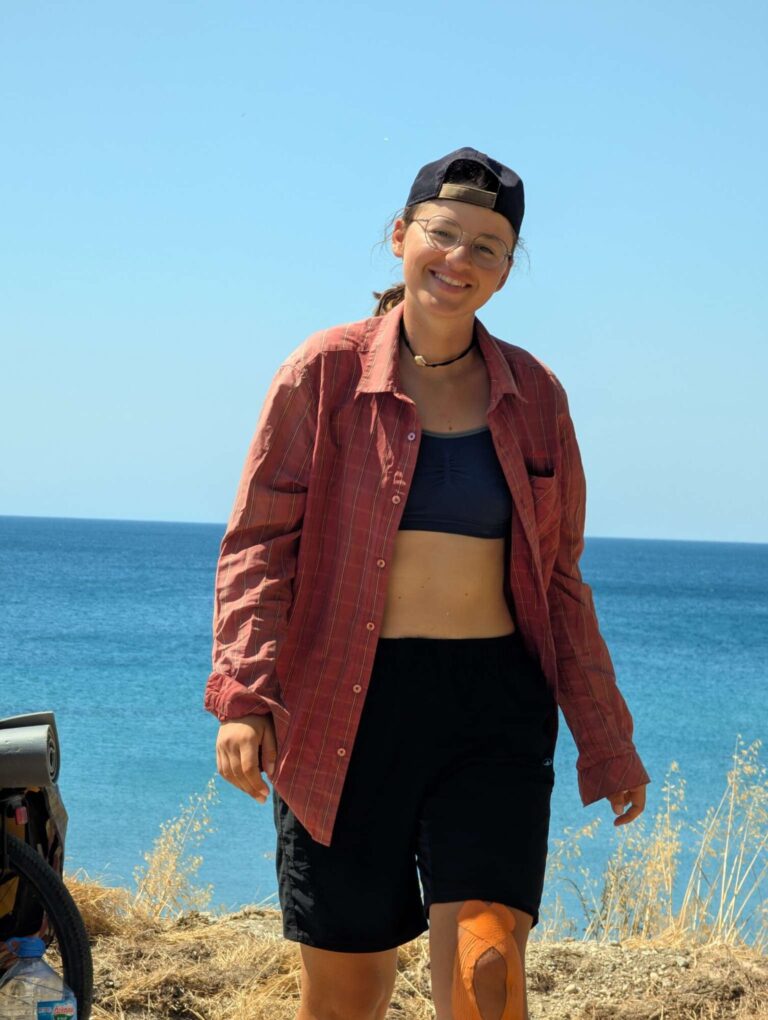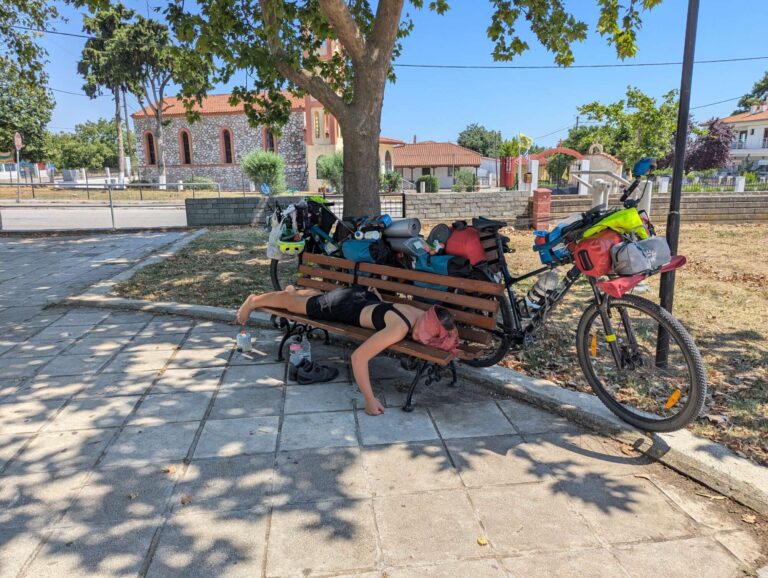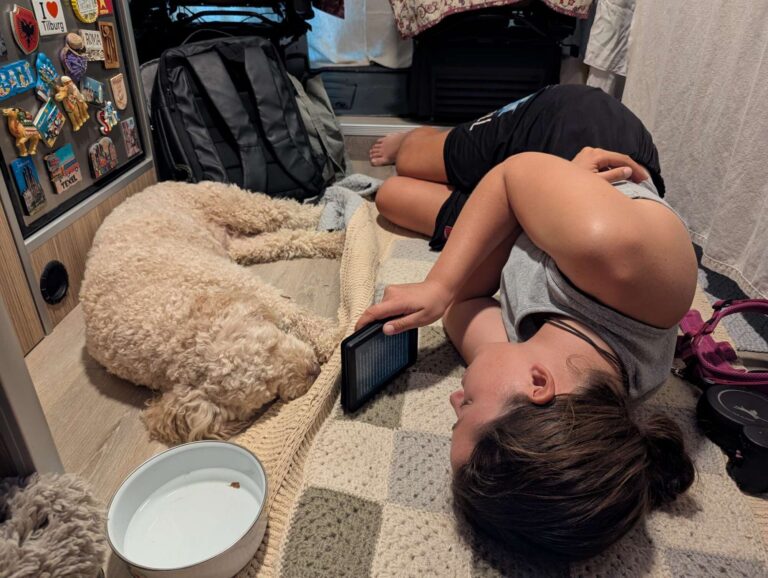Sunday, 29 June, 2025 – Thursday, 24 July, 2025
On Sunday morning, day 26, we left Jugo’s campground, having only 35 kilometers of North Macedonia left. When we reached the border between Macedonia and Greece, there were only around 10 cars ahead of us on the way out of the country. The shock came when we got close to the Greek part of the border—there was a long line of vehicles; we could easily say more than 1 kilometer long and over 100 cars. The line was holding still; people got out of their cars, walked around, ate, smoked, and, if possible, stood in the shade. We were lucky that we could go ahead and pass them on the left. Right before the border we got back into the line, only around 6 cars before us, but even so it took around 15 minutes before we got to the booth. We could see why the process was so painstakingly slow—it wasn’t that they were so strict on the border; the problem was that drivers had to get out of their car, take the documents 3 meters away to the booth, wait there, then go back to their car, get in, buckle up, turn the car back on, and drive away. Because of all that, there was a lot of downtime. We were wondering if the line of cars will clear by the evening.
There’s a Dorian Lake right on the border between Macedonia and Greece, with the border passing on its southern tip. From there we went north on its east coast for around 10 kilometers. We hoped to find a nice camping spot there (marked on iOverlander), but the area was overgrown and abandoned, and the water fountain wasn’t working. We chose a backup spot for camping, then we headed a few hundred meters back south to the abandoned restaurant called “1000 Trees” that we saw before by the road. We explored the place a little bit and decided to stay there for the night. The shade was good under the huge trees, and we cleaned a pair of chairs from the porch to sit down. Several cars passed by while we were there waiting for the sunset; a few of them were police, but the only car that stopped there was a pair of tourists that came to us and asked us for directions. We had no idea how anyone would assume that we had local knowledge of the area, unless they thought we were simply homeless instead of traveling.
Day 27. The joy of getting up at 5:20. Animals around us were unexpectedly loud the whole night (mostly birds and frogs), which woke us up several times. Because of the passing police cars in the evening, we wanted to get away early in the morning. We always feel a bit risky sleeping too close to the borders.
From one lake to the other one. We got to Kerkini Lake, which is known for bird watching, and we spent most of the day on the northwest part of the lake, inside a fairly new and well-maintained park. Good shade, plenty of tables and benches, and a water fountain. It would be hard to get anything better. But sadly we couldn’t sleep there; we asked in the park, and a guy at the bar said that it’s not allowed and that police might check it. So we went south by the lake. There were plenty of cows on the way; a lot of them were eating grass on the swampy edge of the lake, up to their bellies in water. We had to lower our expectations on finding a nice spot for the night; going too far south would bring us into more rural areas where it would be even harder to wild camp. When we found a small road away from the lake, we followed it, and we decided on sleeping there. It was a meadow with a bit of incline—just enough to make you slip down in your tent while you sleep. Being close to the lake meant swarms of mosquitoes, so we had to put on long pants and shirts. The sun was still up, and we were getting hot. Only after a bit of shade fell on our part of the meadow did we set up the inner tent and get inside, away from the mosquitoes. It was hardly any better heat-wise. Lying there in our underwear, we were melting from the heat. It wasn’t until 21:30 that it finally got a bit fresher outside and we could put the rainfly on the tent.
Day 28. You know what’s worse than waking up at 5:20 again? Waking up in a tent with a hole in the waterproof rainfly while the culprits sat all over our tent. Plenty of grasshoppers found our tent comfortable to sit on and munch on it. Tents should be made grasshopper-proof to stay waterproof. Anyway, the sun hadn’t even risen up when it was already hot. And we still had the company of mosquitoes, so we packed up as fast as we could, and we were already on the road when we watched the sunrise.
Everything is better after a good breakfast unless you find mold on your bread. We were left with a few crackers, which fueled us for the next 40 kilometers to a Lidl store. There, we got ourselves a good breakfast, and we ate until we were full like two small pigs. This made us lazy, and we stayed by the store for a few hours until we lost our shade. In the meantime, we went into the store several times to cool ourselves down under the AC inside.
After an additional 20 kilometers, we found a spot for sleeping at the edge of a small vineyard, but it was only 2 PM. We went into the nearby village to pass the time. There, in the center, was a small square with a water fountain and a shade. We washed our clothes, and it was so hot that we used the water to cool ourselves down several times. There was hardly anyone outside during the day, as if the village was completely empty. Even the bar was closed. This lasted until 18:30, when it cooled down enough and people came outside. We saw several airplanes and choppers in the air during the last few hours, but we didn’t think much of it until we suddenly got a warning on our phone—Wildfire in the area. It was 8 kilometers away from us in the direction from which we came. We watched it for a little bit from the top of a hill where the village was, then we headed to our previously chosen spot. It looked like the fire was under control and the wind was blowing away from us. We felt safe enough.
Day 29, Wednesday, was our day off. On the iOverlander app we found a coffee bar called Riverland by the river where one could supposedly stay the night for free, so we headed there. It was only 25 kilometers away, and we arrived before 10 AM. The morning shift didn’t speak English, but the afternoon one did, and they happily allowed us to camp there. There were toilets, wifi, water, and electricity, and we spent most of the day finishing our second blog post of the trip.
In the evening we were told that in the morning someone would come to spray some sort of mosquito pesticide around the bar. And they did. At 7 AM on day 30, a pickup car came with some sort of tank and hose in the back, and they sprayed over all of the surrounding bushes and around the bar area. It seemed that it worked, because we didn’t see any mosquitos the previous evening even though we were right next to the river.
For the last week, we were seeing more and more stray dogs by the road, and we desperately wanted to help them at least in some way. We couldn’t take any of them with us, but the least we could do was feed them. So our highlight of that day was when we bought 2 kilograms of dog food and a few disposable bowls. Our first client was right next to the store, and soon after we met another one. They both got some food and water. Most of those dogs were incredibly humble, especially because they don’t get much love from people; we were amazed how happy they were when we simply didn’t shoo them away.
We skipped breakfast and morning exercise on Friday, day 31, because of the huge spiders on our tent and around us in the grass. After that morning shock, we continued towards Kavala, a bigger city by the coast. Right before we descended into the city, we stopped at a viewpoint, seeing the Greek sea for the first time. Among our wishes for this trip was one about wanting to try different foods as we go through so many countries. When we brainstormed famous Greek food, gyros was high on our list, and we found a nice place in Kavala where we could try it. We were a bit early; because none of the gyros places opened before noon, we found a nice spot in the shade and waited for the next two hours.
When it finally opened, the menu was written in Greek letters, and the lady working inside didn’t speak English, so we ordered the first two versions of gyros off the top of the menu. They both turned out good; the only difference between them was the type of meat inside.
We fed 6 more dogs on day 32. Besides that, not much happened. In the evening, we checked online what weather to expect in the Andes in South America (we should have done this before we even started the trip, but there was always something more important to do). It turned out that we could easily have temperatures below freezing during the night, which didn’t really surprise us (because of the high altitude), but we sort of just ignored this before. The problem was that the temperature rating of our sleeping bags was 10°C (comfort) and 3°C (extreme). This, alongside the occasional usage of emergency blankets from a first aid kit, was enough for colder summer nights in Europe, California, and Mexico, but using those bags in South America would be foolish, to say the least. We were in need of better sleeping bags. So we did some research online and bought two down sleeping bags from Decathlon (Simond MT 900) rated at 0°C (comfort) and -5°C (limit), which should be good enough. We ordered them online in Slovenia and shipped them home with a plan of Primož’s parents bringing them to us before we fly out of Turkey.
On day 33 we finally got a chance to take a shower! It wasn’t a conventional one—we found a water fountain by the road, and we showered with the help of plastic bottles. Iris even managed to wash her hair. It was a great spot to have a longer break—plenty of shade and drinking water. While we chilled there, we met three cyclists, all of them going to Istanbul. It was already afternoon when we decided to go on and get some kilometers in, but this mentality didn’t last long. We stopped by a place called Gyrohouse in Iasmos. The gyros that we got there were even better than the ones we tried two days ago, and the portions were much, much bigger. Iris got a regular-sized one, and Primož got an XXL size, which was a mistake because neither of us could eat it whole. We saved leftovers for dinner. For 8€ we had lunch and dinner.
We got a chance to swim in the Greek sea on day 34. The day was hot, and the water was refreshing, even though we wished for it to be colder. We didn’t stay long because of the sun, and as soon as we were dry, we got back on the bikes. We almost always ride in long shirts to not get sunburns, and because it’s actually colder than being in short sleeves. But all that sun was starting to wear down our shirts. Iris’s one was getting so weathered that it started to tear and get random holes. She did her best to fix it, but we will see how long they will last us.
We couldn’t find a good spot for sleeping in the evening, so we decided to just set up a tent on a wider part of some smaller gravel road. It didn’t look like much traffic passed there, but we placed our bikes next to our tent and put high-vis vests on them in case a car would come by.
It’s a good thing that we did that because we were woken up by a pickup truck driving past us on day 35. We cycled for an hour in the morning, then we spent most of the hot hours in a park in some small village. We used the water fountain several times to wet ourselves to cool down, and a kind neighbor brought us two bottles of cold water during the day. As if that wasn’t enough, an older man came by and invited us to a nearby bar to get some drinks, ice cream, and croissants. Both he and the guy working in the bar insisted on paying for us. We hung there for a while—it was pleasant since they had a fan, which made it less hot, but we couldn’t really chitchat because nobody spoke English, so after a while we left. In the evening we found 2 big dogs with 4 small puppies on the way out, and we fed them.
After 15 kilometers on day 36, a bit before 8 AM, we were at the border between Greece and Turkey. We slept a bit longer than usual that morning, and the sun was already up, so we decided to leave breakfast for later since it was getting hot without shade. Leaving Greece was nothing special; there were less than 10 cars in front of us and a long line of trucks on the side lane (they must have slept there since the border crossing wasn’t open for them during the night). After that, there was quite a long road on no man’s land in-between the countries. We waved at a few young soldiers on the way and took a picture with a big sign for Turkey. What surprised us was the size of the border crossing on the Turkish side. The area was huge, it looked new and well maintained. There weren’t any old or seized cars parked by the side, no trash, and no containers serving as offices. Everyone had to get out of their cars and walk to the booth where the officer checked their passport and took a picture of their face. Everyone also had to open their car trunks for inspection. On the side, we saw a huge building with the word “X-RAY” on it, which was probably meant for trucks. Compared to all that, every other border crossing that we took looked like a joke.
On the Turkish side we somehow ended up on a highway road, so we got off as soon as possible. This led us on a 5-kilometer gravel road with almost no traffic before we got back on the paved road. Instead of going straight toward Istanbul close to the coast, we headed north-east on the roads through fields and smaller villages instead of coastal areas with bigger cities.
We didn’t do much research on the water situation in Turkey; we foolishly hoped that it would be as easy as it has been in Albania, North Macedonia, and Greece. But we found out that not every village has a public fountain at the center and that many of those that do aren’t drinkable. One easy way to find that out is simply by asking locals around the village. Mimicking “drinking” and “ok” as a question is all it takes. Another trick that we found was to just grab an empty water bottle and walk around a bit, as if looking for a fountain; locals were more than happy to jump in and show us where to get water. We weren’t surprised because we’ve already heard about the kindness and hospitality of Turkish people, and now we’ve experienced it firsthand.
We had a tailwind most of the day, a strong one, so getting kilometers in was easier than usual. This also meant that we weren’t as hot during the breaks in shade. What we’ve noticed is that we were thirsty all the time. We drank at least 3 to 4 liters each that day, and even when we were physically sick of drinking more water, we still had an urge to do it. We made sure to get enough salt.
After a bit over 70 kilometers that day, we found a nice spot between some trees, short distance off the road. We saw two trucks of locals driving by, and they waved at us, so we didn’t worry about them. The only concerning thing that evening was someone out there shooting a gun. To make a long story short, it lasted through the whole night, shooting every few minutes. Only in the morning did we figure out that it was probably not a real gun; we suspected it was just a sound to scare birds away from the crops. Anyway, since it scared us in the evening, it was probably good enough for the birds.
Did we already mention Turkish kindness? Well, we can’t overdo it. During the break in the middle of a small village on day 37, two young girls came to us, speaking only Turkish, and they brought us food. First, we got aşure, which is a traditional Turkish dessert made from a variety of grains, legumes, dried fruits, nuts, sugar, and cinnamon. It looked a bit like a broth, and the one we got contained barley, white beans, chickpeas, raisins, dried apricots, peanuts, cinnamon, sugar, nutmeg, and probably a few more things that we didn’t recognize. It was warm and delicious, and we’ve learned that it’s traditionally prepared on the Day of Ashura (in Islamic calendar), which was two days ago. The aşure is often made in large batches and distributed to neighbors, friends, and family—a symbol of sharing and community. Later, the girls came back and brought us a big bag of cucumbers from their garden. We couldn’t thank them and their family enough. When their grandma took a look at Iris, she said that Iris is too skinny, so maybe giving us the cucumbers had something to do with this.
Day after day, more and more people helped us with small kindnesses. We got bottles of cold water multiple times, and we got biscuits, pastries, fruit, and vegetables. On day 39 we stopped in Marmara Ereğlisi at a nice baklava bakery. We got inside, and while we were deciding between what to get, the man working there (probably the owner) gave us two teaspoons of ice cream to try. We usually don’t have a safety switch when we should stop with sweets, so we got two of almost everything to try. We tried 4 different baklavas and an ice cream. Besides the fact that we first got complimentary cold water on the side, when we wanted to pay, the owner refused to take the money. He insisted that everything was on him. It wasn’t as much about the money (it was probably around 5€ in total); we were more touched by his attitude and how he thanked us for coming there to eat.
We were getting close to Istanbul, and we still had almost two weeks before our flight to South America. Just like last year, on the first part of our trip in Barcelona, Primož’s parents would come to us before the flight. They became sort of our support crew. They would bring us cardboard boxes for our bikes and luggage, alongside several other things that we decided to switch out or add to our equipment.
That was one of the reasons why we got close to the sea, and we stopped at several campgrounds along the way. The other one was that we were ripe to take a shower. Having time to relax and do some more planning and washing our clothes and our bikes would also be nice. But when we heard the prices of 25€ to 35€ per night at campgrounds without shade, with old and dirty bathrooms, and some with people so packed together that we would have to hammer our tent pegs under neighbors’ tents, we changed our minds. Wildcamping in Turkey was easy, so it felt like a waste of money paying for a campground. We decided to rather spend a fraction of that money to try different local dishes.
On Sunday, day 40, we found a beach close to Silivri that was full of locals. But most of them would go home in the evening, and we could easily camp there alongside a few locals who would do the same. We had somewhere around 60 kilometers left to Istanbul Airport and plenty of time left. We stayed there for 4 nights. With the kind permission of our neighbor at that beach, who had his summer residence there in the shape of a camping trailer, we could stay in the shade at the porch in front of one of the trailers. This, alongside the constant fresh wind, made the days bearable over the constant heat. It got much better during the evening when the sun went behind the trees, and the air was fresh and almost cold during the night. Our new friend spoke Serbian (besides Turkish), which we needed more than a day to figure out, but it made the communication very easy. He even invited us for dinner one evening, serving grilled chicken with rice, and we met his family.
On Thursday, day 44, we left the coast and went a bit inland. On the way, we found a nice park with benches and plenty of shade, and we spent most of the day there. We looked for accommodation in the town where we were to land in South America. We also extended our travel insurance, updated our Instagram, wrote a bit of this blog, and did some research on what would be the best route to take in South America. As you might guess, we had no clear idea where to go; if nothing else, we would make our plans on the go. Day 45 was very similar, and we even slept at the same spot on the cut-down wheat field.
On the Saturday evening of day 46, Primož’s parents arrived, and we went to a campground called “Camping Sole” close to Kadıköy. The plan was to stay there for the next 5 days. We would pack our bikes and equipment in boxes, do some planning, and relax in the meantime. We got our new sleeping bags, and we put new rear tires on both of our bikes since they were getting weathered and cracked from the sun. When we took off the old tires, we found 5 thorns and pieces of glass that got through and would pop the inner tube if it weren’t for Tannus—a rubber inlay that goes between the tire and inner tube and protects it. You can read more about Tannus on their website.
What’s next? We have a flight to Ecuador in South America in the afternoon of day 52. But more on that in the next blog post.
Some more pictures:

